Select a theme to learn more
Select an image to learn more
Torah Binder
A Torah binder keeps the Torah closed when it is not in use. Different traditions of its form and decoration have arisen in various communities. For example, in Germanic (Ashkenazi) lands the swaddling cloth for the circumcision ceremony of a male child was later decorated with words and images to wish him well. In Italy women embroidered floral patterns and sometimes inscriptions on a length of cloth expressing hopes and thanks for important events.
Owl
This novelty spice container imitates sixteenth-century silver cups with bodies made of a nautilus shell or ostrich egg. Such objects were a staple of the collections of curiosities belonging to Renaissance nobles. It was created in Germany around the turn of the twentieth century when there was a craze for older historical objects.
Mezuzot
The mezuzah is a scroll containing biblical verses that declare one’s love of God and recall the human covenant with the divine. Placed within a case or covered, and set on the doorposts of a home or public building, it serves as a reminder of identity and obligation.
Esther Scroll Cases
The biblical book of Esther recounts the story of a Jewish woman who became queen of Persia and was able to save Persian Jews from death at the hands of Haman, the king’s vizier. It is read aloud in synagogue during the festival of Purim. The text, written in scroll form, is often housed in an ornamental case.
Painted Wood
These two works came to the Jewish Museum from American Jewish institutions where they served as symbols of faith and charity. Detached from the context for which they were made, they have lost their original symbolism, but placed together here, they acquire new narratives. For example, both simply carved wooden objects were coated in inexpensive gold paint, rather than gold leaf, to appear impressive when their creators had limited means.
Ship Model
Traditional cabinets of curiosities often feature miniatures, cunningly made, often of precious materials. Like many institutions with a broad mission—focusing on art, but with strong attention to culture and history—the Jewish Museum has acquired an eclectic range of objects. The two model ships in this room were commissioned for exhibitions on the antiquities of Israel. Long since detached from that purpose, they remain works of fine craftsmanship, resonant with a sense of the distant past—both that of the Mideast and that of the museum.
Torah Crowns
To emphasize the majesty and preeminence of the Torah scroll as it is displayed or paraded around the synagogue, many communities place a crown over the Torah staves. This may allude to a saying by the second-century rabbi Shimon bar Yohai: “There are three crowns: the crown of Torah, the crown of priesthood, and the crown of kingship. But the crown of a good name excels them.”
Torah Shields
Shields are hung around the staves of the Torah scroll when it is not in use. They may have begun as devices to mark the specific reading that a scroll was turned to, but later served to ornament and beautify this holiest object in Judaism. Shields themselves are often decorated; those selected here all are adorned with colored glass cabochons.
Torah Shields
Shields are hung around the staves of the Torah scroll when it is not in use. They may have begun as devices to mark the specific reading that a scroll was turned to, but later served to ornament and beautify this holiest object in Judaism. Shields themselves are often decorated; those selected here all are adorned with colored glass cabochons.
Torah Stave Fittings
These bone pieces were elements of Torah staves. They were discovered by laborers working in the grounds of the main synagogue in what was then Grodno, Soviet Union (today Hrodna, Belarus), and were covered with dirt. It is probable that they were removed from the Torahs before or during World War II because they were of value, but whether the act was intended to save or defile the holiest object in Judaism is unknown.
Buildings
The works shown here are among the museum’s several miniature architectural models.
Torah Shield
Shields are hung around the staves of the Torah scroll when it is not in use. They may have begun as devices to mark the specific reading that a scroll was turned to, but later served to ornament and beautify this holiest object in Judaism. Shields themselves are often decorated; those selected here all are adorned with colored glass cabochons.
Cinnamon
Layers of cinnamon impregnated with glue were built up inside mail-order boxes to create the blocks of Lucy Puls’s aromatic version of a spice container for the end of the Sabbath.
Spice Containers
During the havdalah ceremony that separates the Sabbath from the work week, spices such as cloves, myrtle, or nutmeg are passed among those present so that they may enjoy the sweet aroma, thought to offer comfort for the loss of the holy day. In Renaissance Germany and Eastern Europe, containers in the form of a tower became popular, in some cases imitating specific buildings. The idea is probably based on Christian monstrances and censers with architectural forms.
The earliest known example of a spice container shaped like a miniature tower is in the Jewish Museum collection, and is on view in the Constellations Scene.
Torah Staves, Finials, and Fittings
The staves of the Torah, to which the parchment scroll is sewn, are called “trees of life” in Hebrew. The association of this tree with the Torah is reflected in a passage in the biblical book of Proverbs that is recited during Torah services in the synagogue: Wisdom “is a tree of life for those who take hold of it, and happy is everyone who holds it fast.” As a means of honoring and beautifying the sacred text, the upper portion of the staves can be ornamented with elaborate carving, and finials or crowns are often fitted on the tips.
Bone, Ivory, Horn, Shell
Beginning in antiquity, ivory, horn, bone, and shell have been used to create both utilitarian and luxury objects. All have fine, smooth surfaces and can be carved into intricate, fragile forms. Today, the collection, sale, and importation of some of these products are banned in parts of the world in order to protect the species.
Work
Torah binder of Gerson, son of Yaakov Dov Newman
Date
1871
Artist
B. Y. Behr, nationality unknown, birth and death dates unknown
Place Made
New York
Medium
Painted linen
Credit Line
Gift of Dr. Harry G. Friedman, F 5578
A German or American Torah binder typically states in Hebrew the name of the boy to whom it is dedicated and his date of birth. The creator of a binder, however, is seldom mentioned. On its lower left corner, this binder unexpectedly singles out its artist in Yiddish: “Made in New York by B. Y. Behr, 1871”; in English, it adds his business address, 264 Stanton Street, on Manhattan’s Lower East Side. The boy’s birthdate, December 29, 1867, is inscribed in Hebrew. The binder was made closer to the date of its dedication to the synagogue, usually around the time the boy turned three and began his formal religious education.

Work
Spice container
Date
Between the late nineteenth and early twentieth century
Artist
Unknown, firm of Neresheimer, founded in 1890
Place Made
Hanau, Germany
Medium
Repoussé, chased, and cast silver, glass, and coconut shell
Credit Line
The Rose and Benjamin Mintz Collection, M 282

Work
Mezuzah case
Date
Between the late eighteenth and the first half of the nineteenth century
Artist
Katz Barg
Place Made
Poland
Medium
Parcel-gilt silver
Credit Line
Gift of Louis M. Rabinowitz, JM 75-48

Work
Mezuzah case
Date
Nineteenth century
Artist
Unknown
Place Made
Europe
Medium
Carved fruitwood and glass
Credit Line
Gift of the Danzig Jewish Community, D 85
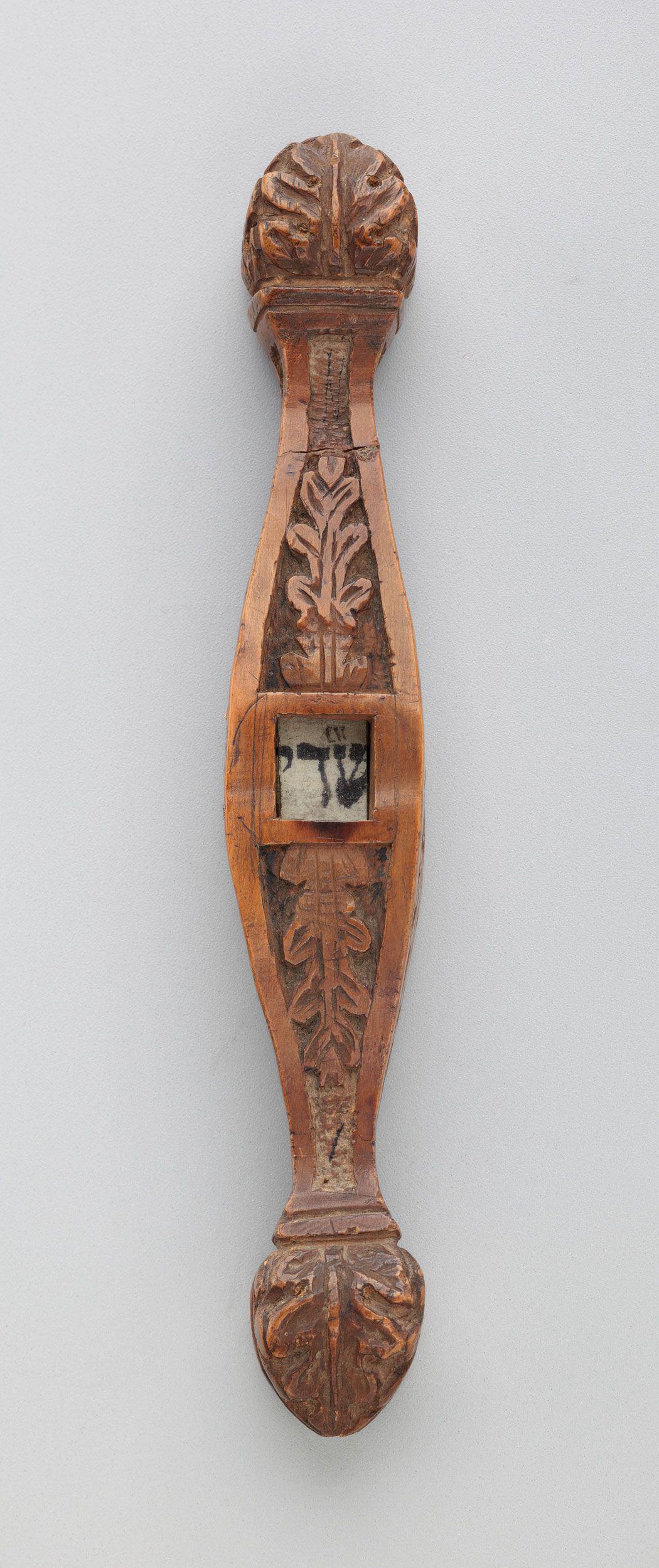
Work
Mezuzah case
Date
Between 1950 and 1961
Artist
Ilya Schor; American, born in Złoczow, Galicia (now Zolochiv, Ukraine), 1904, died in 1961
Medium
Pierced and chased silver
Credit Line
Bequest of Earl and Irene Morse, 1997-46
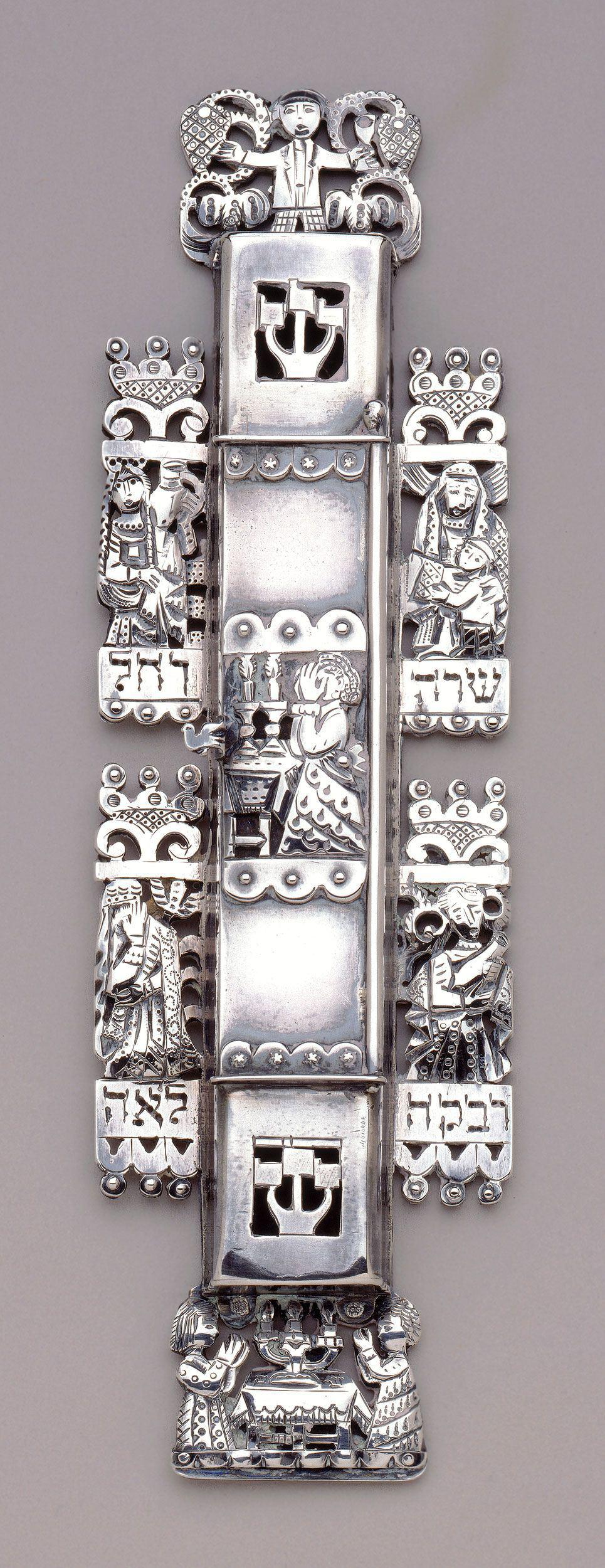
Work
Mezuzah case
Date
1950s
Artist
Unknown
Place Made
Israel?
Medium
Silver filigree
Credit Line
Gift of Dr. Harry G. Friedman, F 4877

Work
Mezuzah case
Date
Early 1980s
Artist
Unknown
Place Made
Mumbai
Medium
Cast brass
Credit Line
Gift of Erna and Samuel Daniel Divekar in memory of his parents Lt. Michael Daniel Divekar and Yerushabai Michael, 1990-160

Work
Mezuzah case
Date
Between 1950 and 1960
Artist
Unknown
Place Made
Jerusalem
Medium
Cast silver with granulation and filigree
Credit Line
Gift of Mrs. William Linder, 1987-57
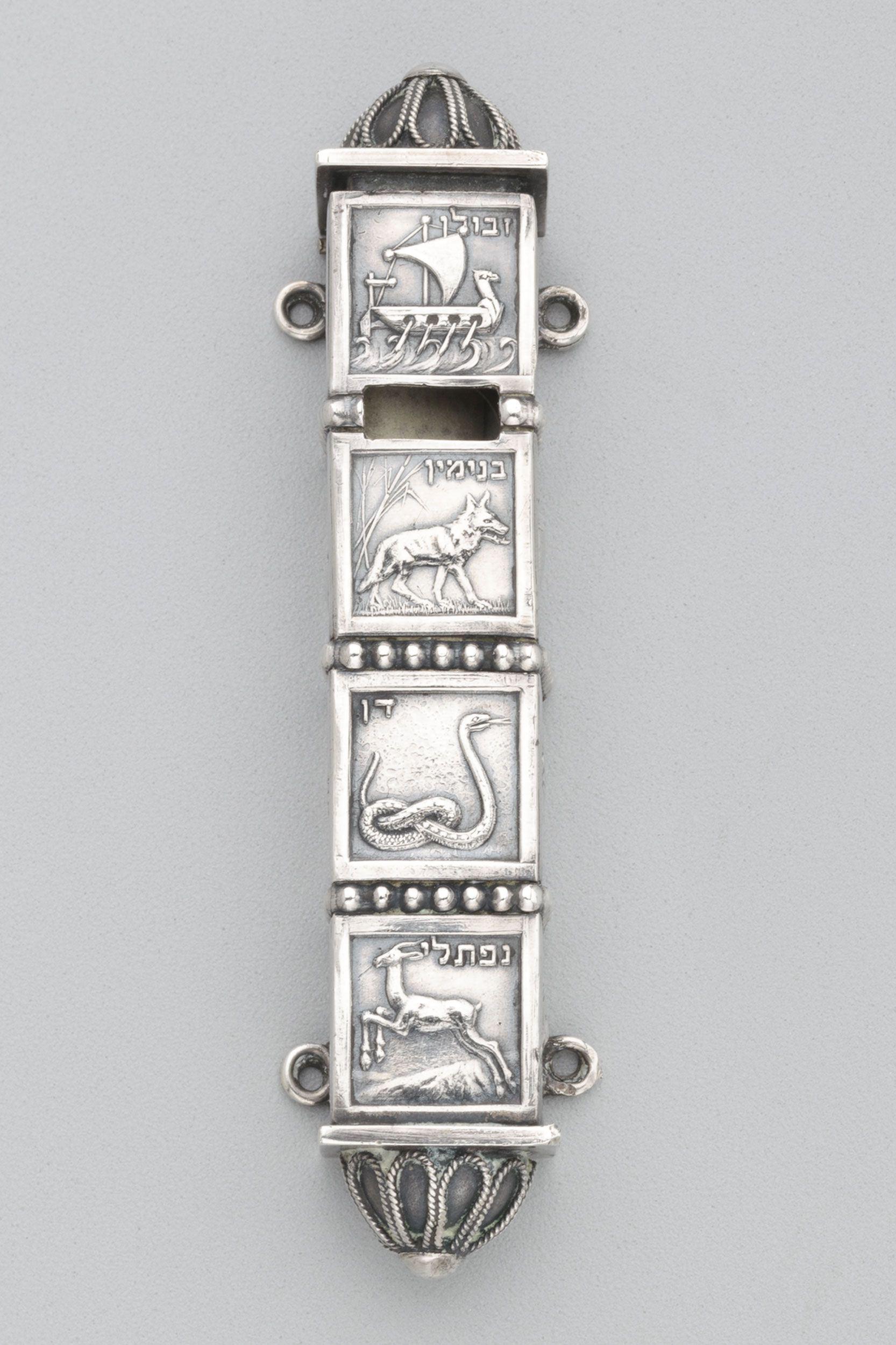
Work
Esther scroll case
Date
Late nineteenth or early twentieth century
Artist
Unknown
Place Made
Ottoman Empire
Medium
Gilt cast silver with filigree, granulation, and coral
Credit Line
F 6544
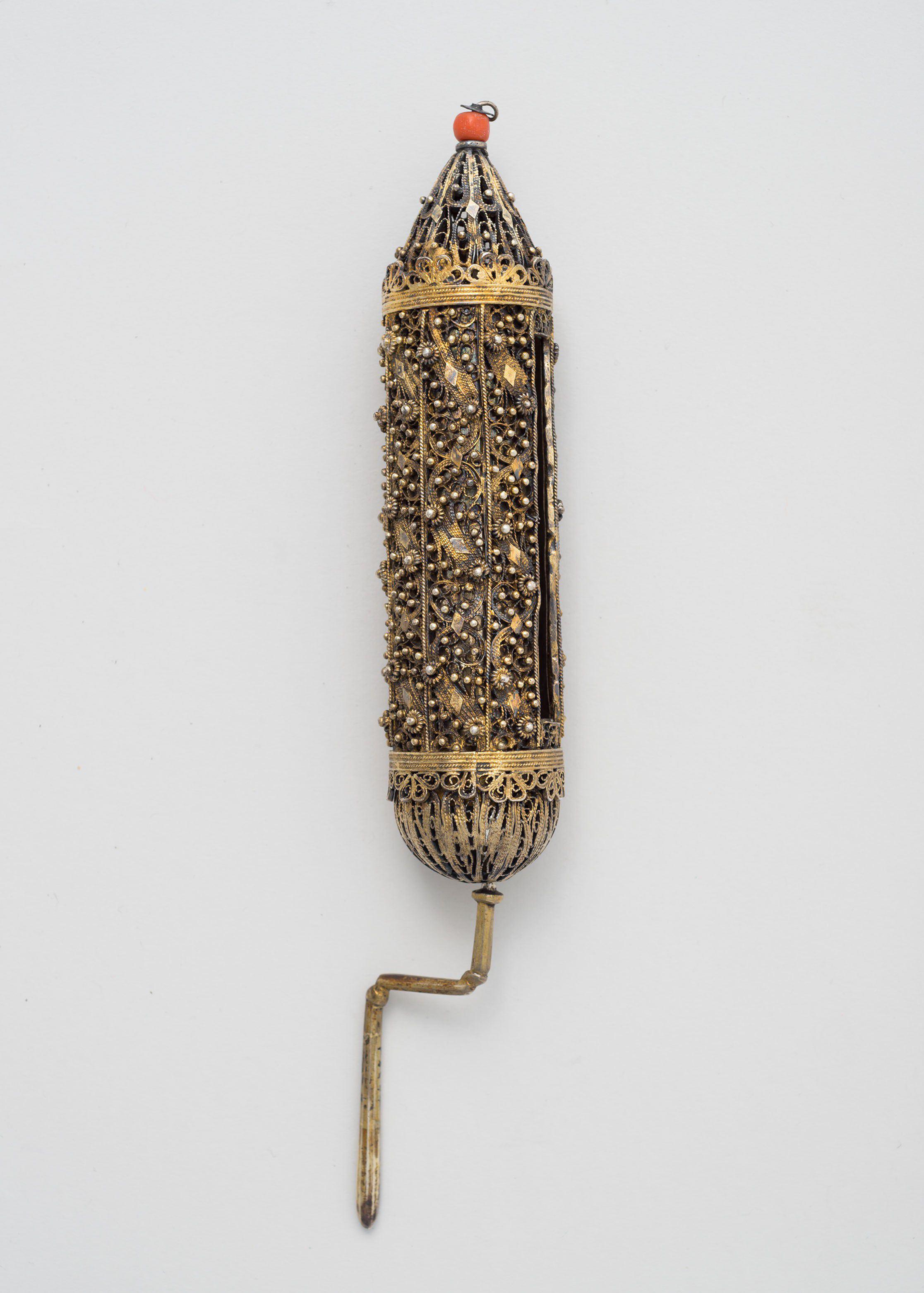
Work
Esther scroll case
Date
1912
Artist
Unknown
Place Made
United States?
Medium
Traced, engraved, and cast silver, and glass
Credit Line
Gift of Dr. Harry G. Friedman, F 4601
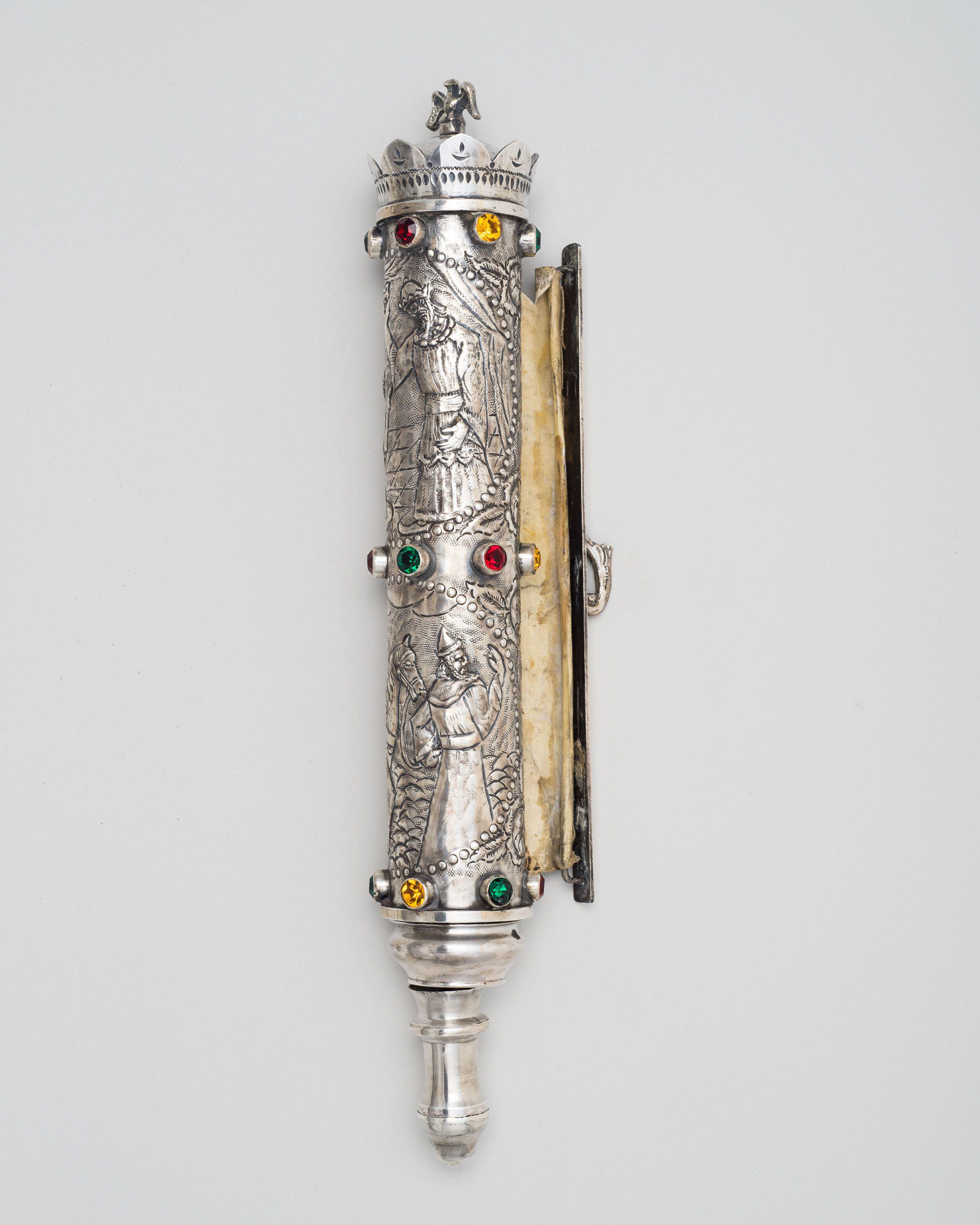
Work
Esther scroll case
Date
Nineteenth century
Artist
Unknown
Place Made
Poland or Israel?
Medium
Gilt silver with filigree and glass
Credit Line
Gift of Dr. Harry G. Friedman, F 5387
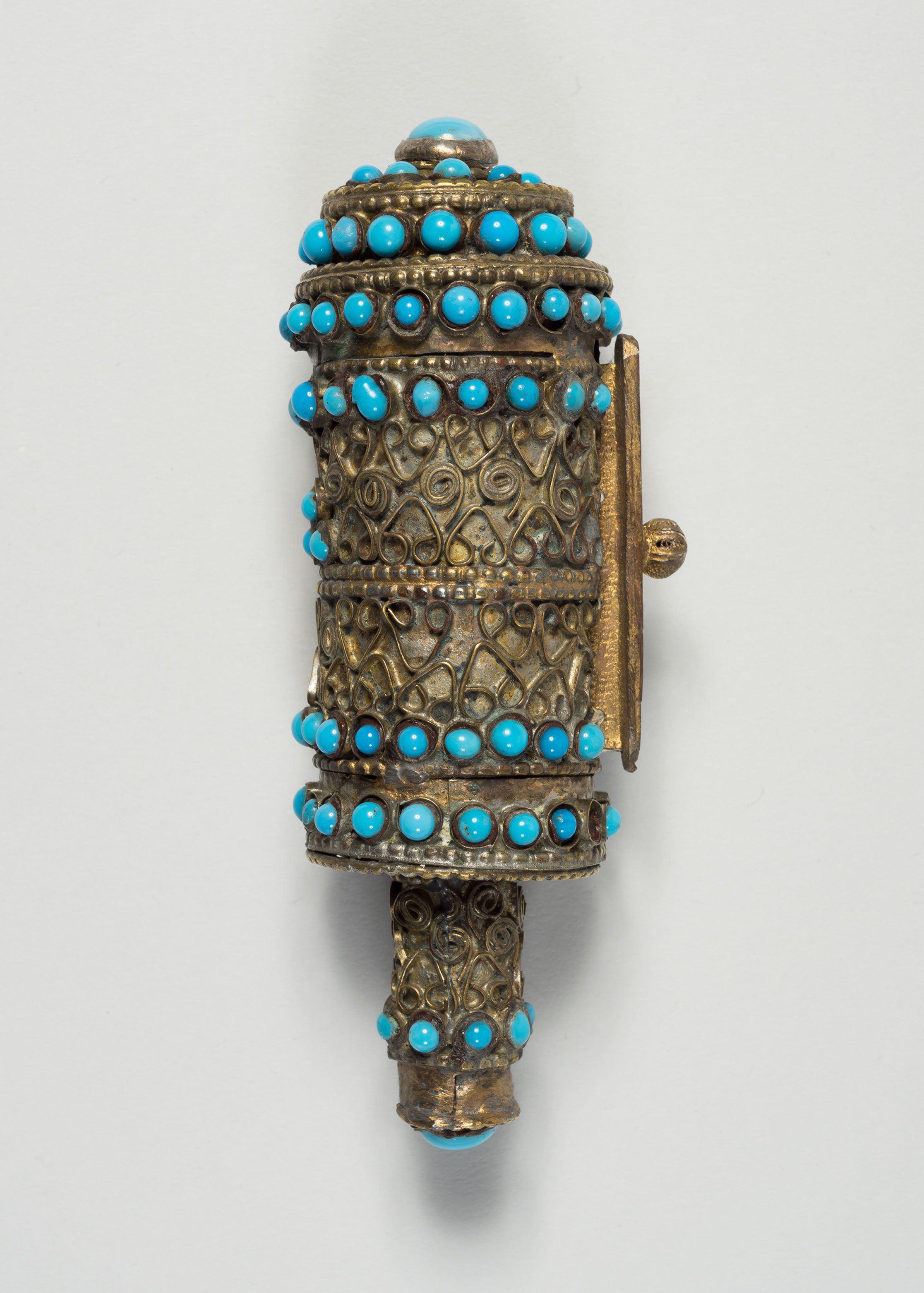
Work
Esther scroll case
Date
Nineteenth century
Artist
Unknown
Place Made
Europe or the Ottoman Empire
Medium
Cast, granulated, and filigree silver
Credit Line
Gift of Ernest and Phyllis Harrison in memory of their parents, 1989-166

Work
Esther scroll case
Date
Late nineteenth or early twentieth century
Artist
Unknown
Place Made
Greece
Medium
Parcel-gilt, cast, engraved, traced, repoussé, punched, and hammered silver
Credit Line
Gift of Dr. Harry G. Friedman, F 5664
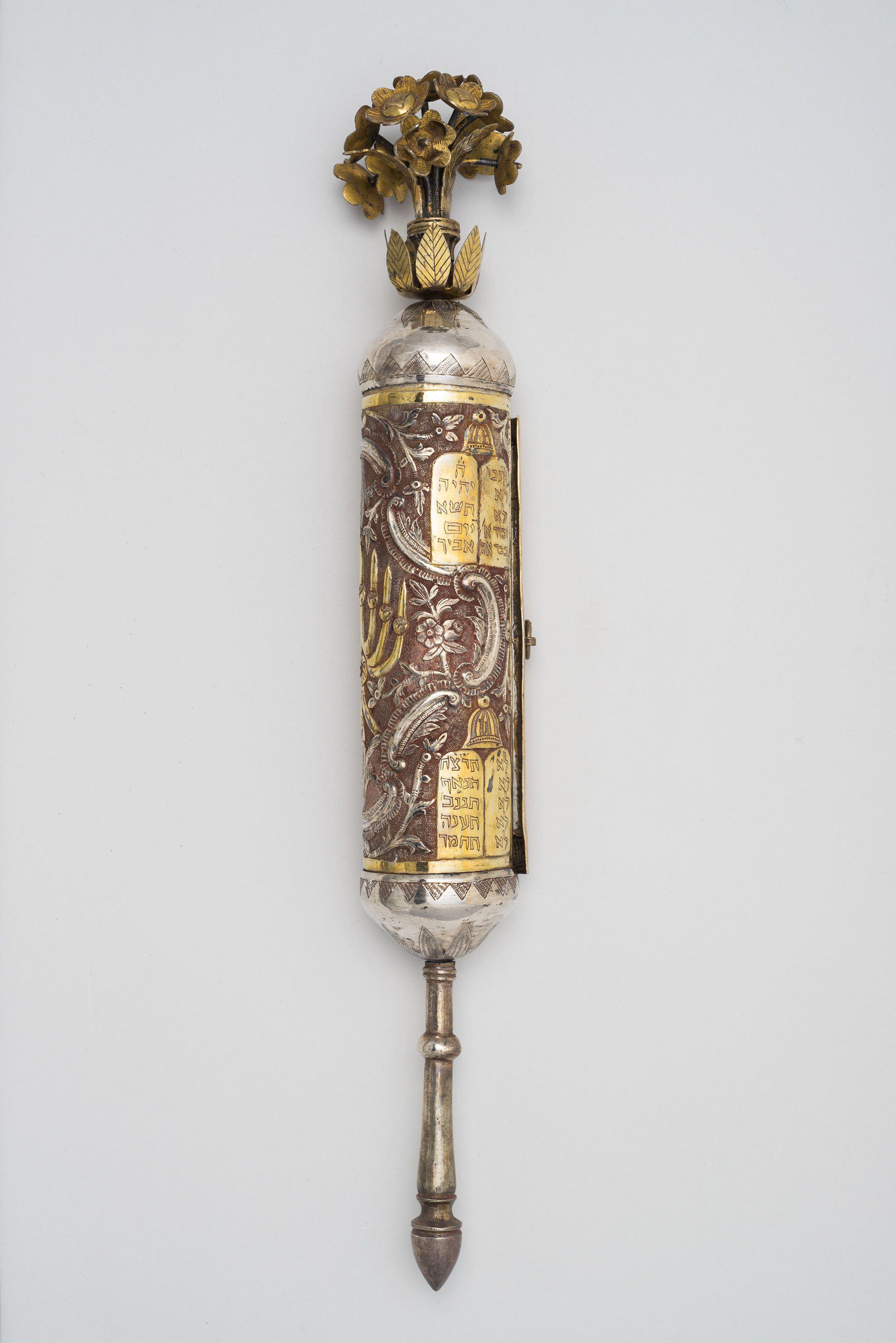
Work
Esther scroll case
Date
Nineteenth or early twentieth century, with later additions
Artist
Unknown
Place Made
Ottoman Empire?
Medium
Pierced, chased, and cast silver
Credit Line
Gift of Dr. Harry G. Friedman, F 5333
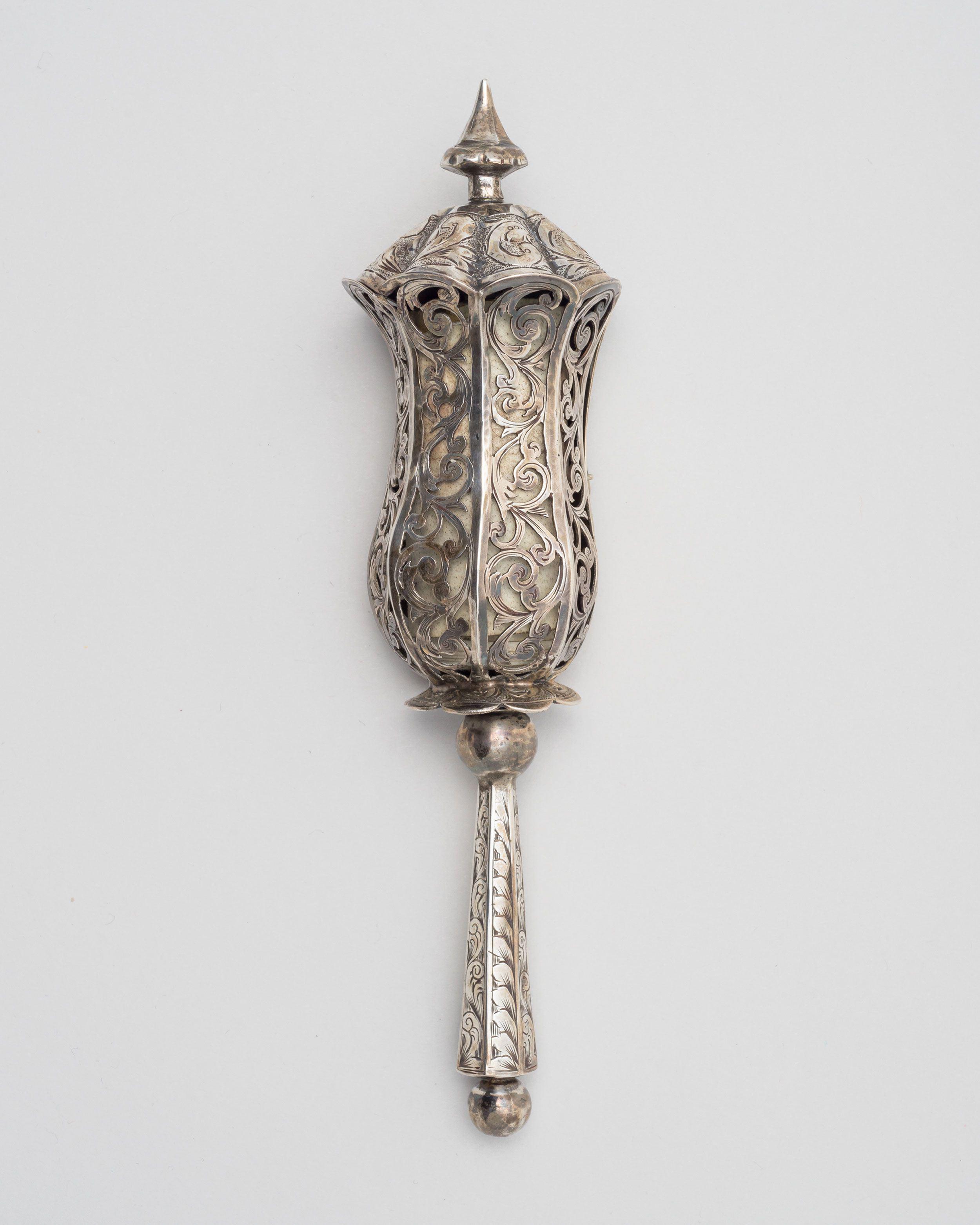
Work
Esther scroll case
Date
Late nineteenth century
Artist
Unknown
Place Made
Ottoman Empire
Medium
Gilt silver with filigree and granulation, and coral or glass
Credit Line
Gift of Dr. Harry G. Friedman, F 1830

Work
Esther scroll case
Date
1829
Artist
Unknown
Place Made
Saint Petersburg, Russia
Medium
Repoussé, traced, punched, and cast silver
Credit Line
Gift of Dr. Harry G. Friedman, F 5810

Work
Presentation key
Date
1914
Artist
Unknown
Place Made
New York
Medium
Painted wood
Credit Line
Gift of Dr. Harry G. Friedman, F 4333
This key commemorated the opening of the Hebrew National Orphan House in New York in 1914.

Work
Blessing hands from a Torah ark
Date
1893
Artist
Unknown
Place Made
Boston
Medium
Carved and incised wood with gilt and gold paint
Credit Line
Gift of Dr. Harry G. Friedman, F 4751f-g
These hands repeat a gesture made by the ancient priests and their descendants to bless the congregation. They were made to decorate a Torah ark in the Tifereth Israel synagogue in Boston and were originally embellished with gold leaf. When they were later retouched, gold paint was used, suggesting a shift in the fortunes of either the synagogue or the sculpture itself.

Work
Sidonian merchantman ship model
Date
1973, after a relief of the second or third century CE
Artist
Unknown
Place Made
Haifa
Medium
Painted wood, cord, and cloth
Credit Line
Gift of Joy Ungerleider, JM 14-73
In the 1970s a new director of the Jewish Museum with a passion for the antiquities of Israel mounted a number of exhibitions on the subject. This model ship was commissioned from the Haifa National Maritime Museum for one such show. The Phoenicians of Lebanon were known for their maritime prowess. This replica of a first- or second-century CE merchant vessel from Sidon is based on a depiction found on a stone relief.
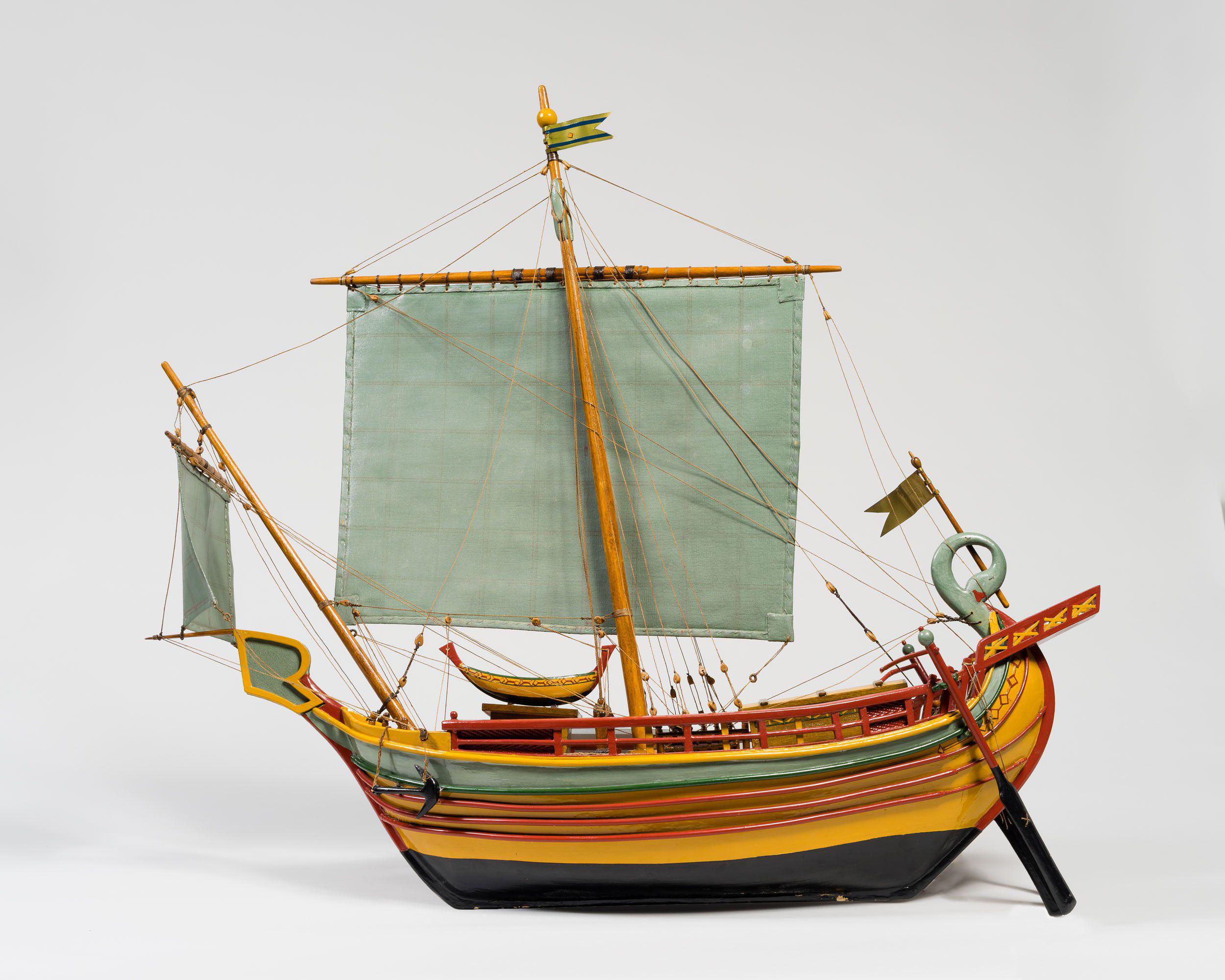
Work
Torah crown
Date
Nineteenth century
Artist
Unknown
Place Made
Poland
Medium
Cast and die-stamped silver or other metal with glass and turquoise
Credit Line
Gift of Dr. Harry G. Friedman, F 3711
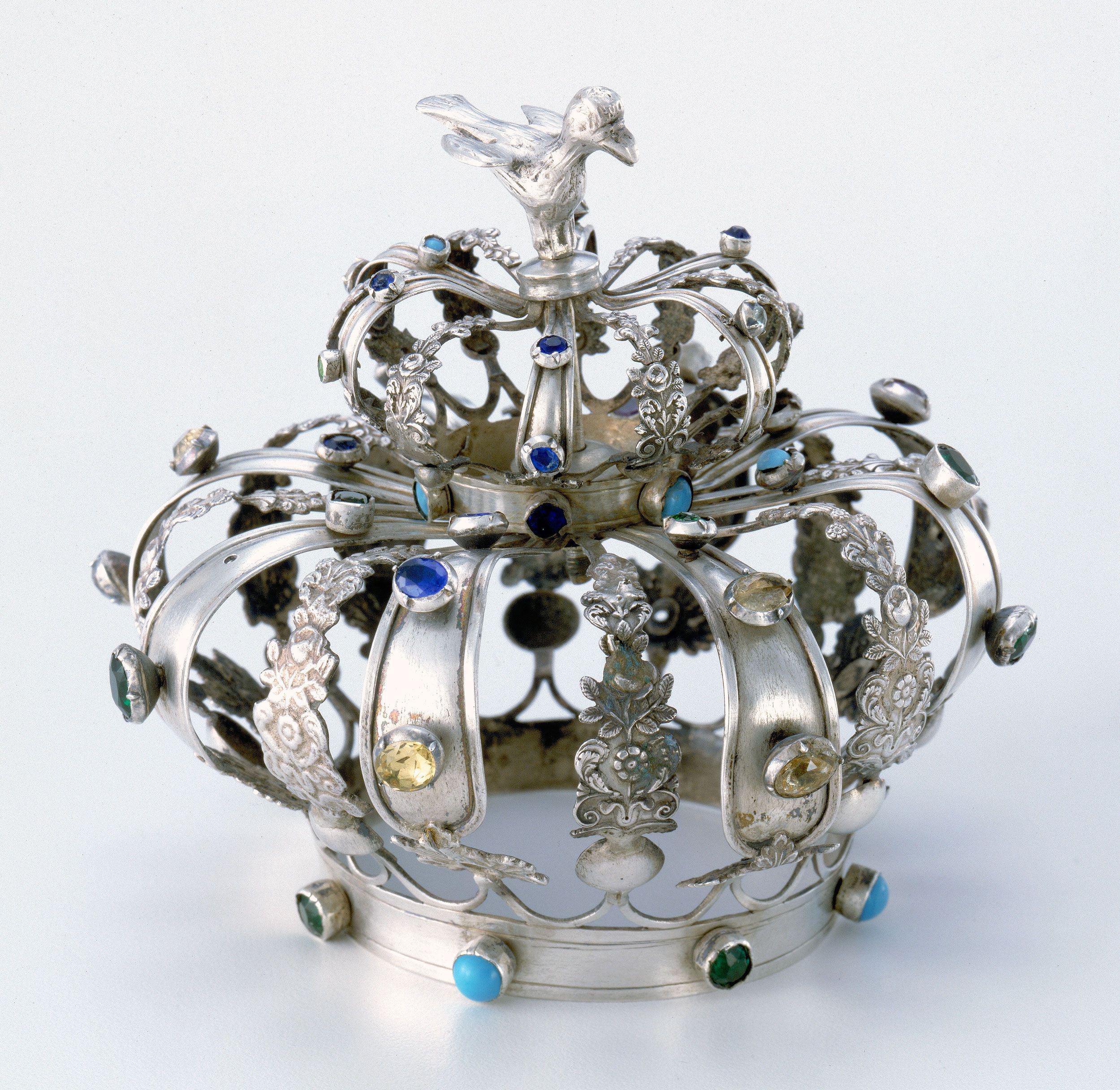
Work
Torah crown
Date
c. 1780?
Artist
Unknown
Place Made
Galicia (now in Poland and Ukraine)
Medium
Cast, traced, engraved, and parcel-gilt silver with silver niello, stones, and glass
Credit Line
Gift of Leo Seifter in memory of his father, Sigmund Seifter, F 1904

Work
Torah crown
Date
1920s
Artist
Unknown, Bezalel School of Arts and Crafts
Founded in Jerusalem in 1906
Place Made
Jerusalem
Medium
Die-stamped silver, silver filigree, carved ivory, and turquoise
Credit Line
Gift of W. Henry Gamson in memory of Israel Rokeach, JM 28-57
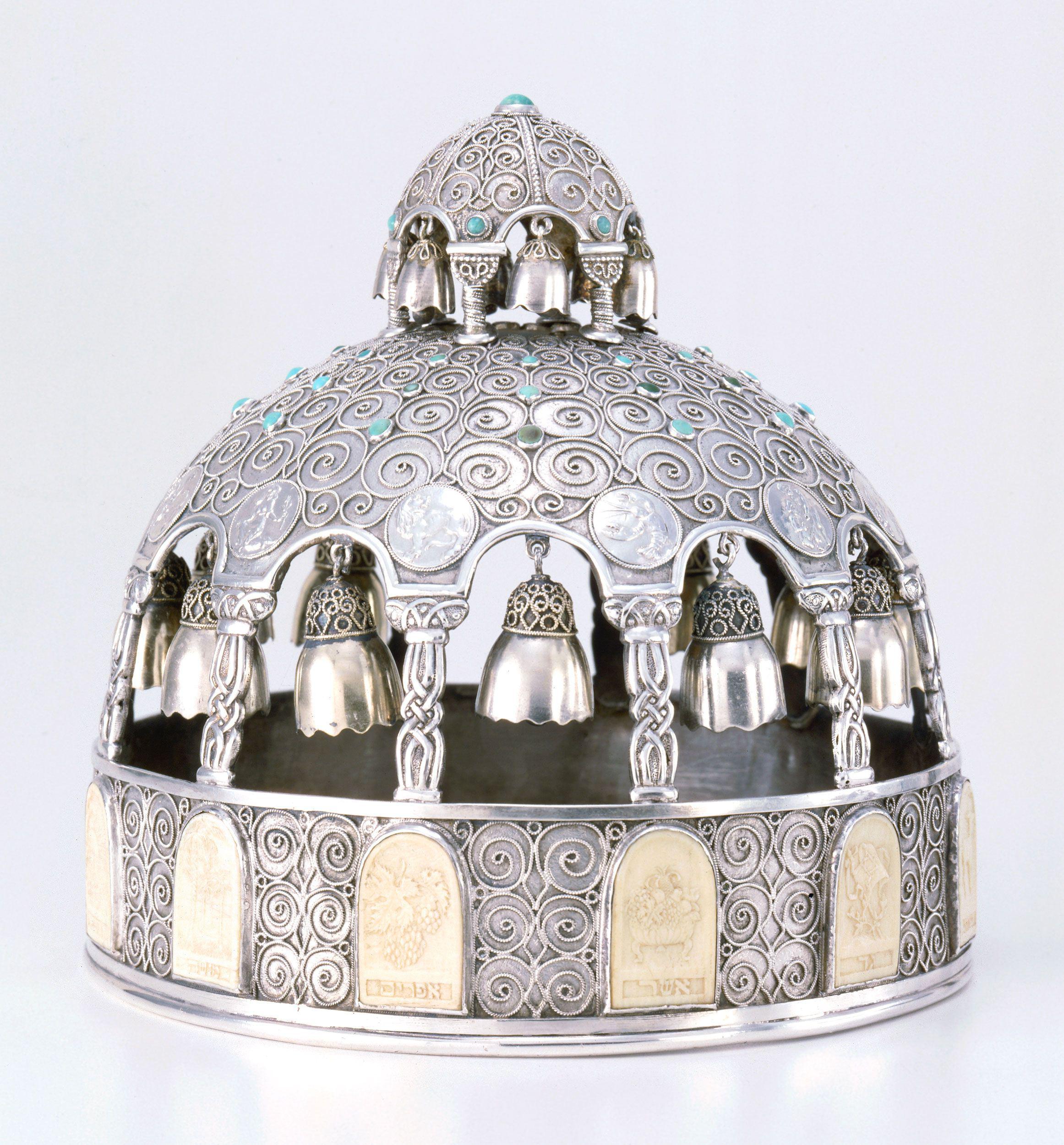
Work
Torah crown
Date
1817–18 with 1873–74 addition
Artist
Unknown
Place Made
Galicia (now in Poland and Ukraine)
Medium
Chased, pierced, and parcel-gilt silver with semiprecious stones and glass
Credit Line
Gift of Max M. Karp in memory of his father, Michael Karp, S 1363a

Work
Torah or Haftorah crown
Date
Between 1725 and 1750
Artist
Johann Michael Ernst II; German, active between 1717 and 1741
Place Made
Munich
Medium
Repoussé, pierced, and parcel-gilt silver and glass
Credit Line
Gift of Dr. Harry G. Friedman, F 1749
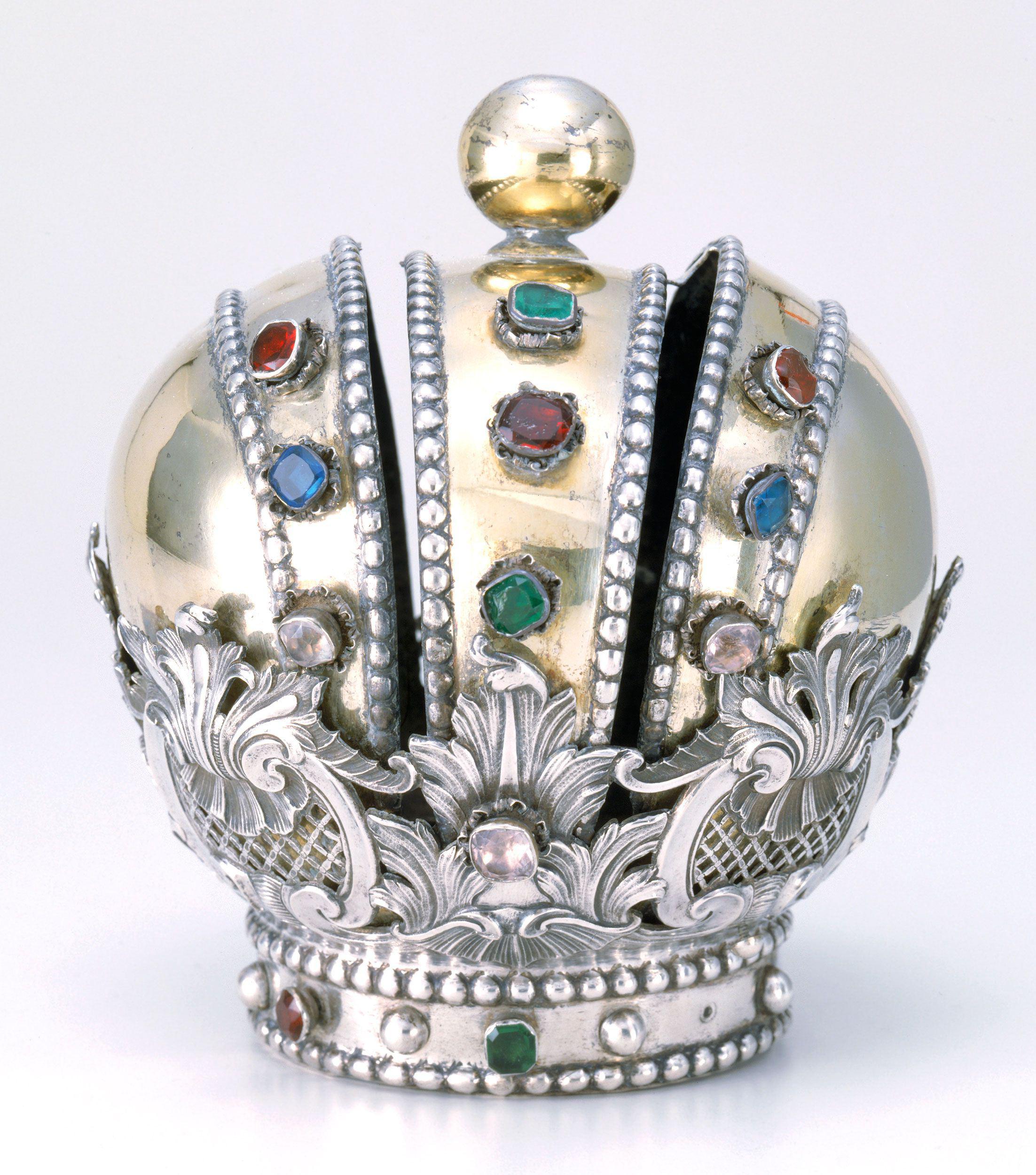
Work
Torah crown
Date
Late eighteenth or early nineteenth century
Artist
Unknown
Place Made
Galicia (now in Poland and Ukraine)
Medium
Cast, chased, engraved, and parcel-gilt silver with glass
Credit Line
Gift of Dr. Harry G. Friedman, F 4040

Work
Torah shield
Date
Early nineteenth century
Artist
Unknown
Place Made
Galicia (now in Poland and Ukraine)
Medium
Repoussé, cast, engraved, and parcel-gilt silver, carnelian, and coral
Credit Line
The Rose and Benjamin Mintz Collection, M 261

Work
Torah shield
Date
Between c. 1875 and 1900
Artist
I. Blum
Place Made
Europe
Medium
Cast, engraved, and parcel-gilt silver, glass, and felt
Credit Line
Gift of Dr. Harry G. Friedman, F 3247

Work
Torah shield
Date
1796–97
Artist
Wolfgang Schubert
German, born in 1741, died in 1816
Place Made
Nuremberg, Germany
Medium
Repoussé, cast, and engraved silver and glass
Credit Line
Gift of Dr. Harry G. Friedman, F 1982
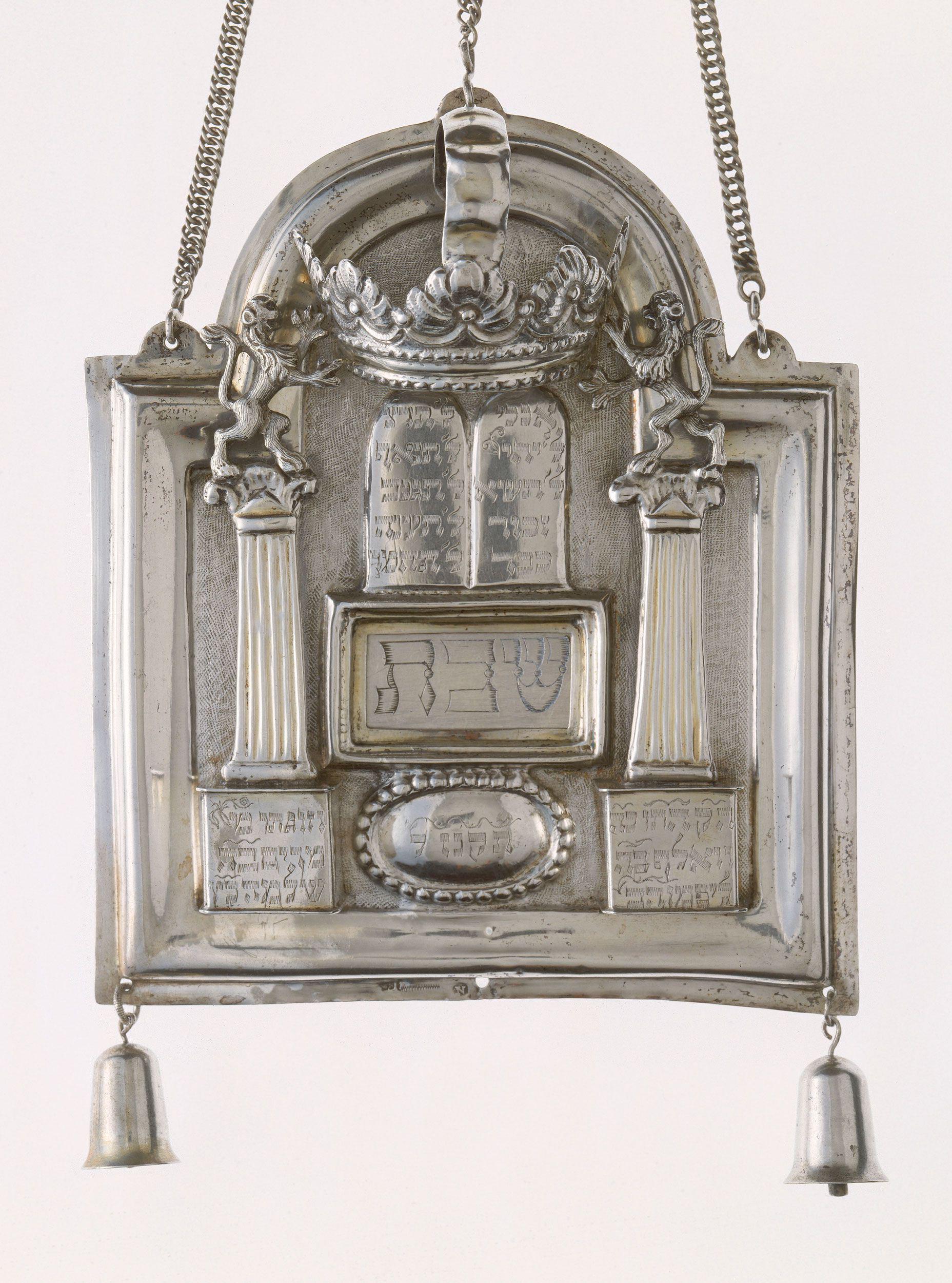
Work
Torah shield
Date
Late eighteenth or early nineteenth century
Artist
Unknown
Place Made
Hungary?
Medium
Repoussé, cast, engraved, and parcel-gilt silver and glass
Credit Line
Gift of Dr. Harry G. Friedman, F 3459

Work
Torah shield
Date
Eighteenth century
Artist
Unknown
Place Made
Possibly Lissa (now Leszno, Poland)
Medium
Repoussé, cast, and parcel-gilt silver and glass
Credit Line
Gift of Dr. Harry G. Friedman, F 2548

Work
Torah shield
Date
Nineteenth century
Artist
Unknown
Place Made
Galicia (now in Poland and Ukraine)
Medium
Silver filigree, chased and parcel-gilt silver, brass, and glass
Credit Line
Gift of Dr. Harry G. Friedman, F 241

Work
Fitting for Torah staves
Date
Before 1941
Artist
Unknown
Place Made
Grodno, Russian Empire (now Hrodna, Belarus)
Medium
Drilled and incised bone
Credit Line
Gift of Lisa Palkes, 1987-48
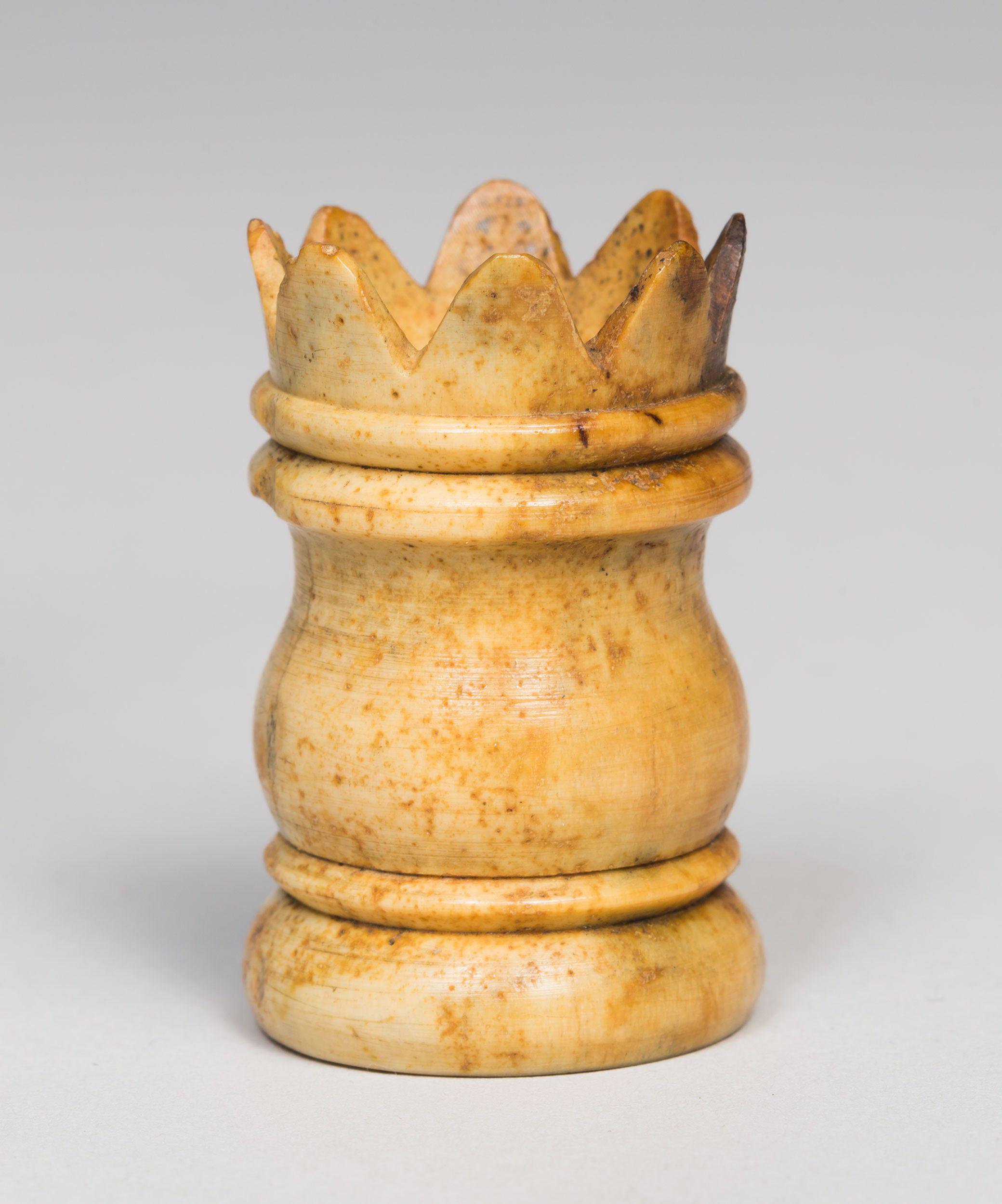
Work
Fitting for Torah staves
Date
Before 1941
Artist
Unknown
Place Made
Grodno, Russian Empire (now Hrodna, Belarus)
Medium
Drilled and incised bone
Credit Line
Gift of Lisa Palkes, 1987-54
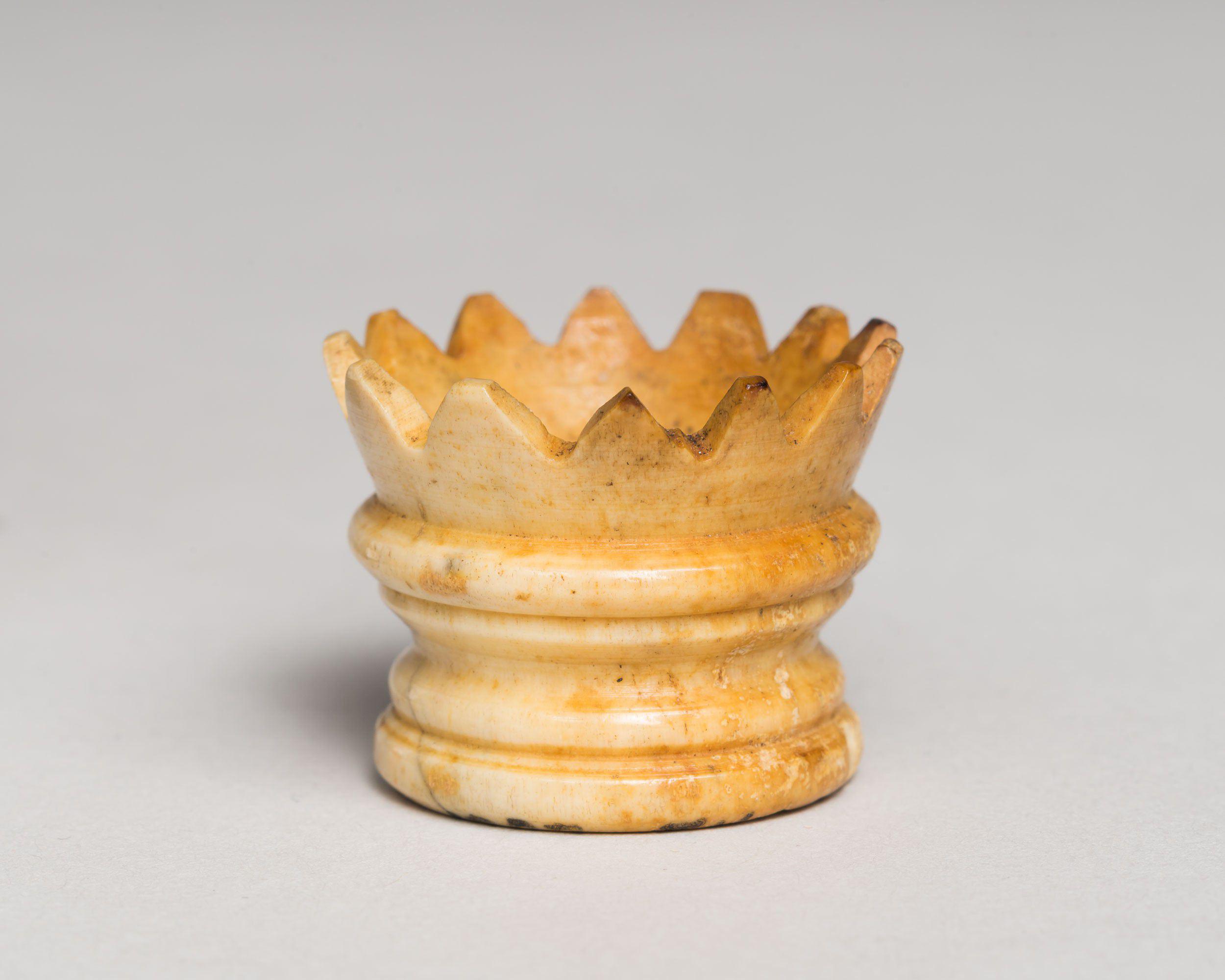
Work
Fitting for Torah staves
Date
Before 1941
Artist
Unknown
Place Made
Grodno, Russian Empire (now Hrodna, Belarus)
Medium
Drilled and incised bone
Credit Line
Gift of Lisa Palkes, 1987-44
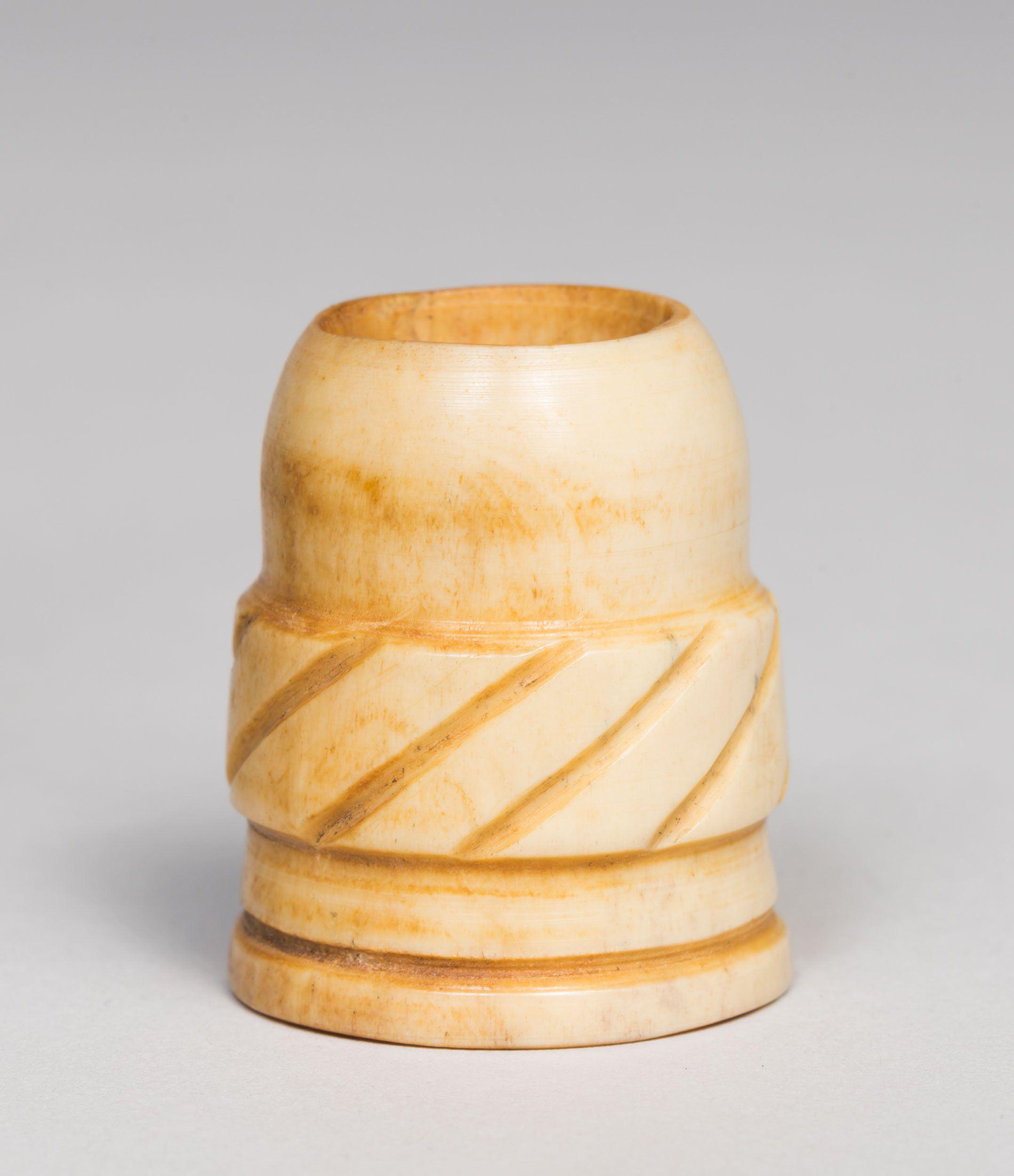
Work
Fitting for Torah staves
Date
Before 1941
Artist
Unknown
Place Made
Grodno, Russian Empire (now Hrodna, Belarus)
Medium
Drilled and incised bone
Credit Line
Gift of Lisa Palkes, 1987-51
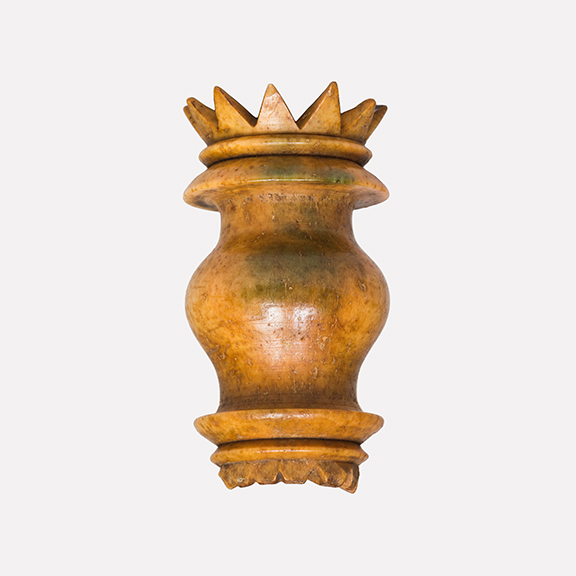
Work
Fitting for Torah staves
Date
Before 1941
Artist
Unknown
Place Made
Grodno, Russian Empire (now Hrodna, Belarus)
Medium
Drilled and incised bone
Credit Line
Gift of Lisa Palkes, 1987-47

Work
Fitting for Torah staves
Date
Before 1941
Artist
Unknown
Place Made
Grodno, Russian Empire (now Hrodna, Belarus)
Medium
Drilled and incised bone
Credit Line
Gift of Lisa Palkes, 1987-56
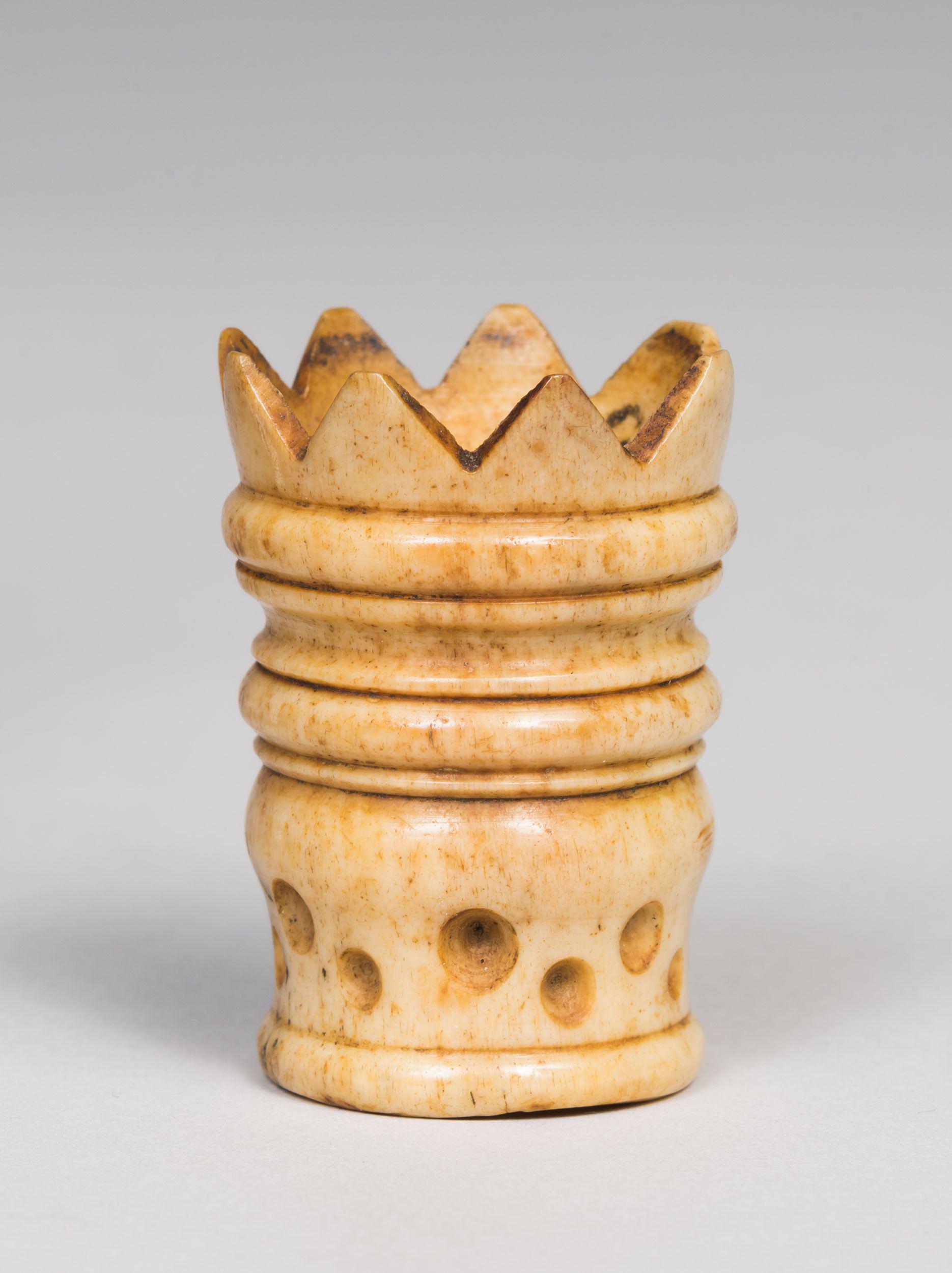
Work
Fitting for Torah staves
Date
Before 1941
Artist
Unknown
Place Made
Grodno, Russian Empire (now Hrodna, Belarus)
Medium
Drilled and incised bone
Credit Line
Gift of Lisa Palkes, 1987-49

Work
Fitting for Torah staves
Date
Before 1941
Artist
Unknown
Place Made
Grodno, Russian Empire (now Hrodna, Belarus)
Medium
Drilled and incised bone
Credit Line
Gift of Lisa Palkes, 1987-42
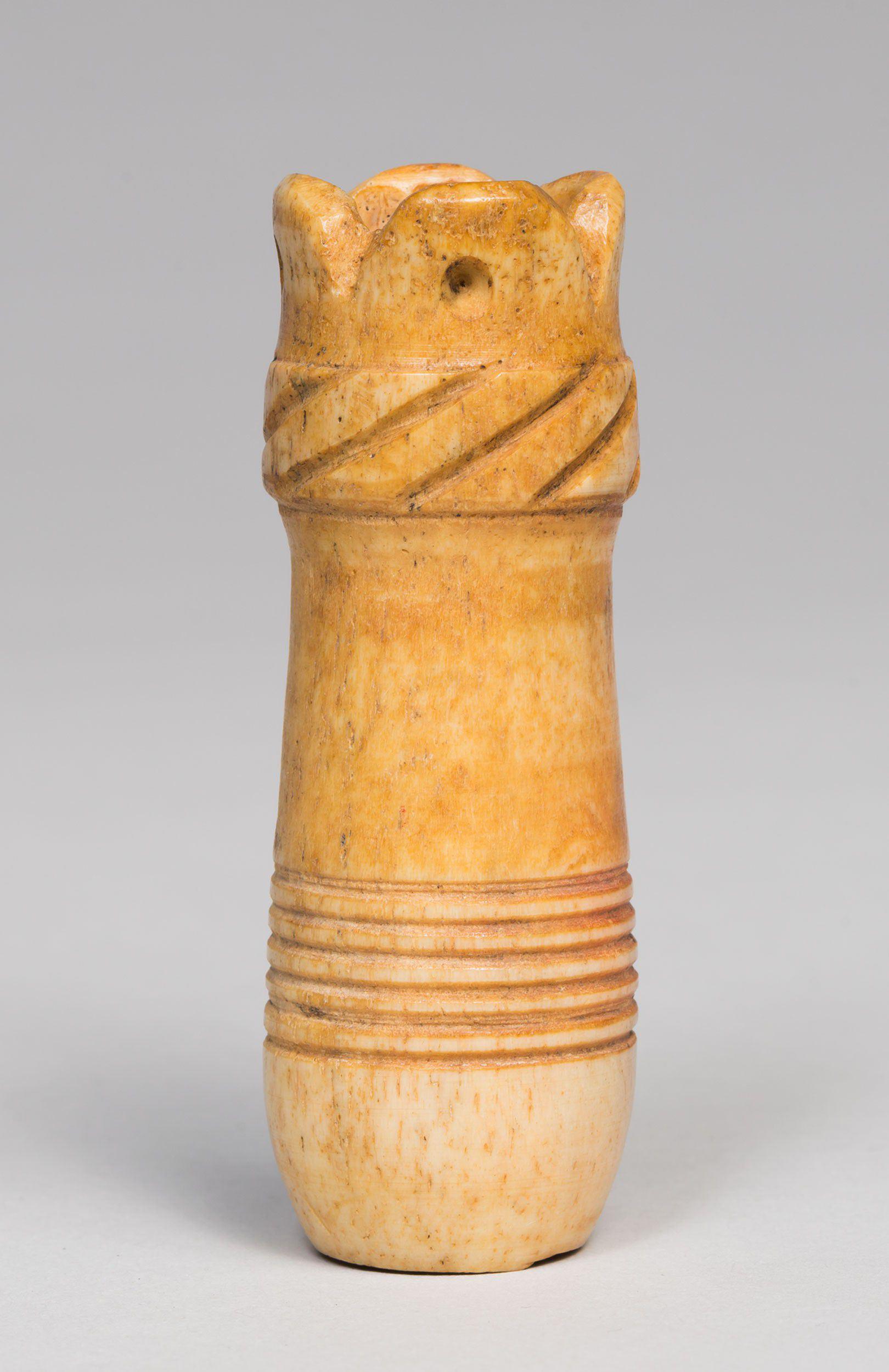
Work
Fitting for Torah staves
Date
Before 1941
Artist
Unknown
Place Made
Grodno, Russian Empire (now Hrodna, Belarus)
Medium
Drilled and incised bone
Credit Line
Gift of Lisa Palkes, 1987-45
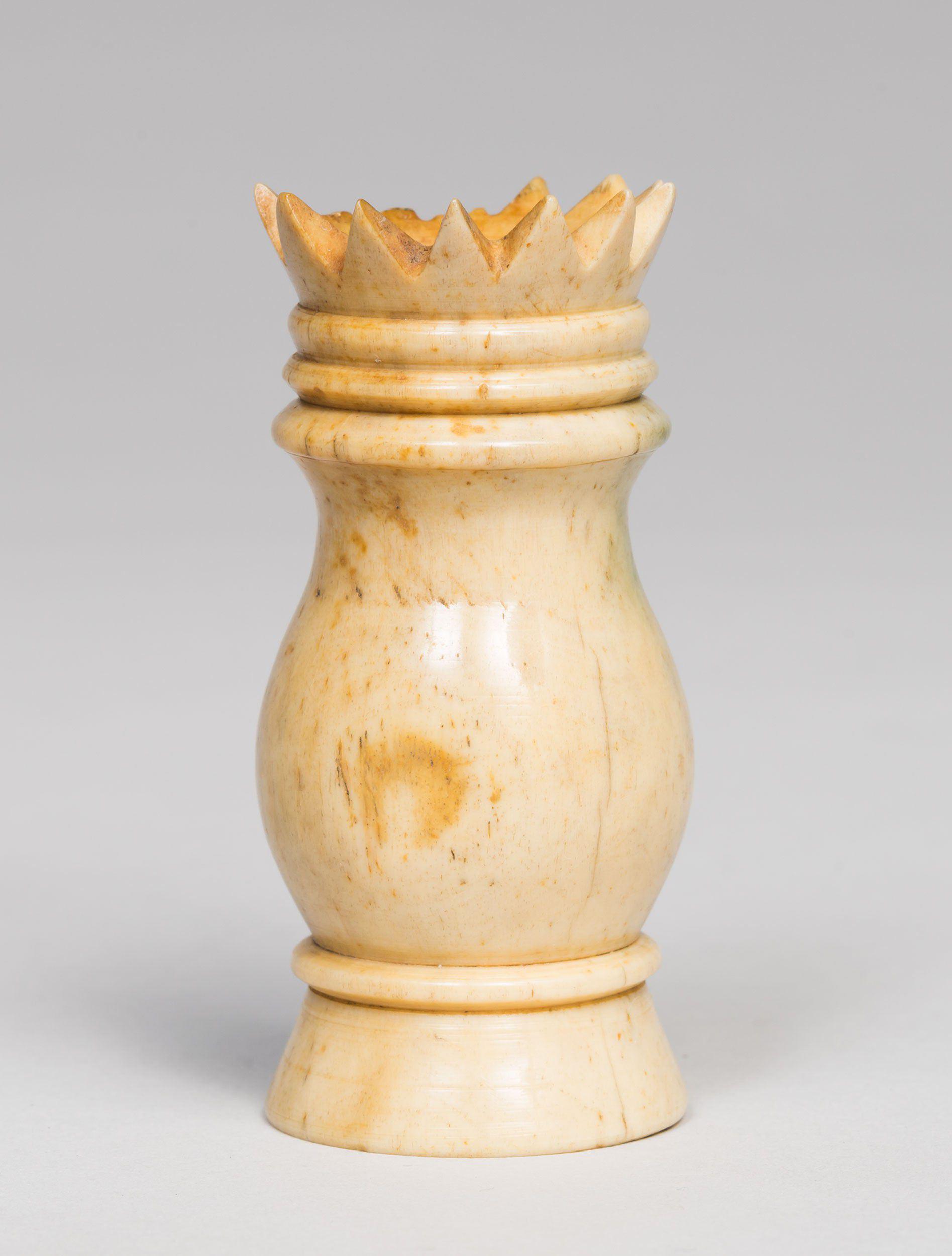
Work
Fitting for Torah staves
Date
Before 1941
Artist
Unknown
Place Made
Grodno, Russian Empire (now Hrodna, Belarus)
Medium
Drilled and incised bone
Credit Line
Gift of Lisa Palkes, 1987-53
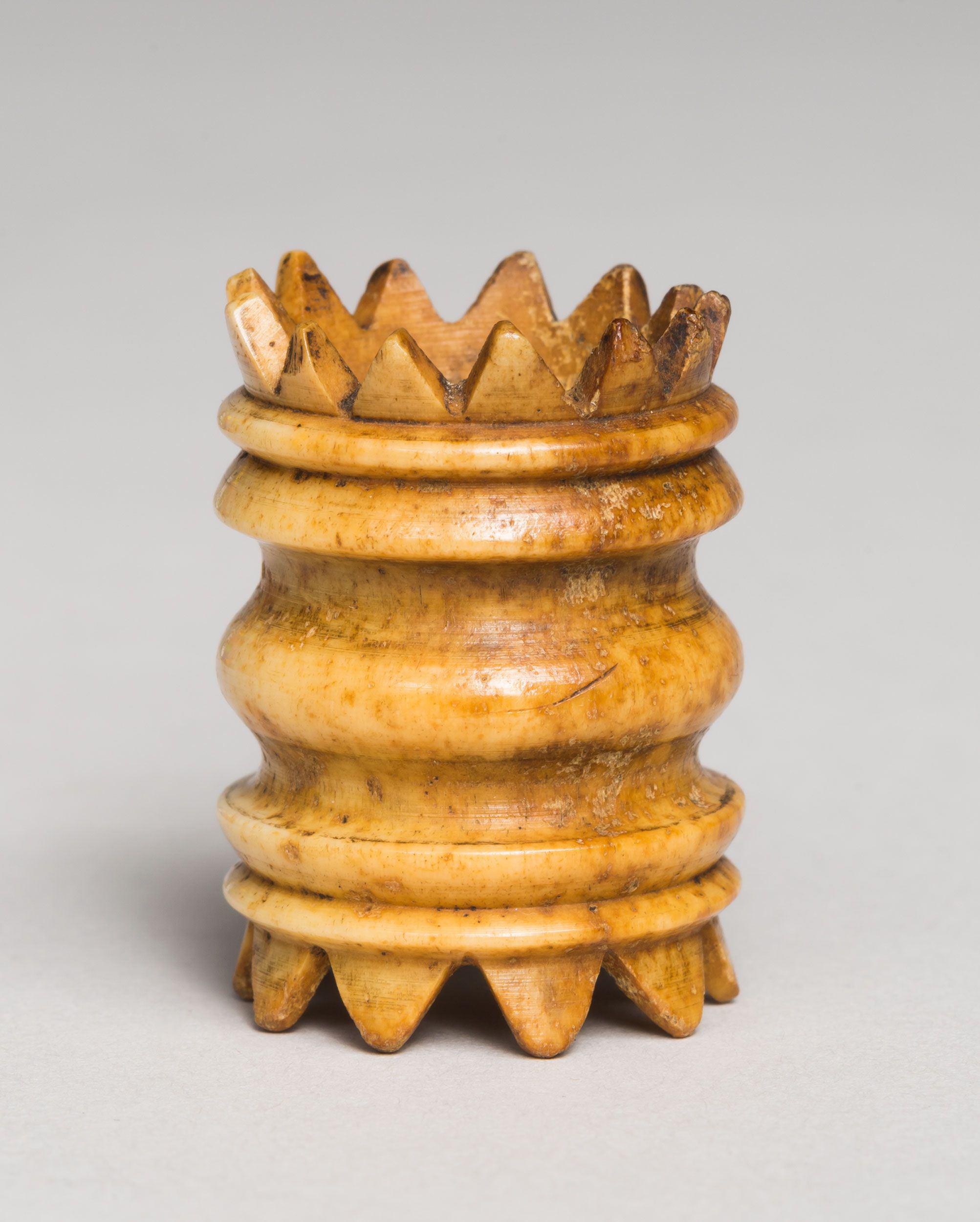
Work
Model of the Second Temple in Jerusalem in a Bottle
Date
1813
Artist
Moses Formstecher; German, born in Gehaus, Germany, 1760, died in Offenbach, Germany, 1836
Place Made
Offenbach, Germany
Medium
Half post-blown glass, wood, paint, and metal
Credit Line
Gift of Mr. and Mrs. Louis Bial, JM 21-79a
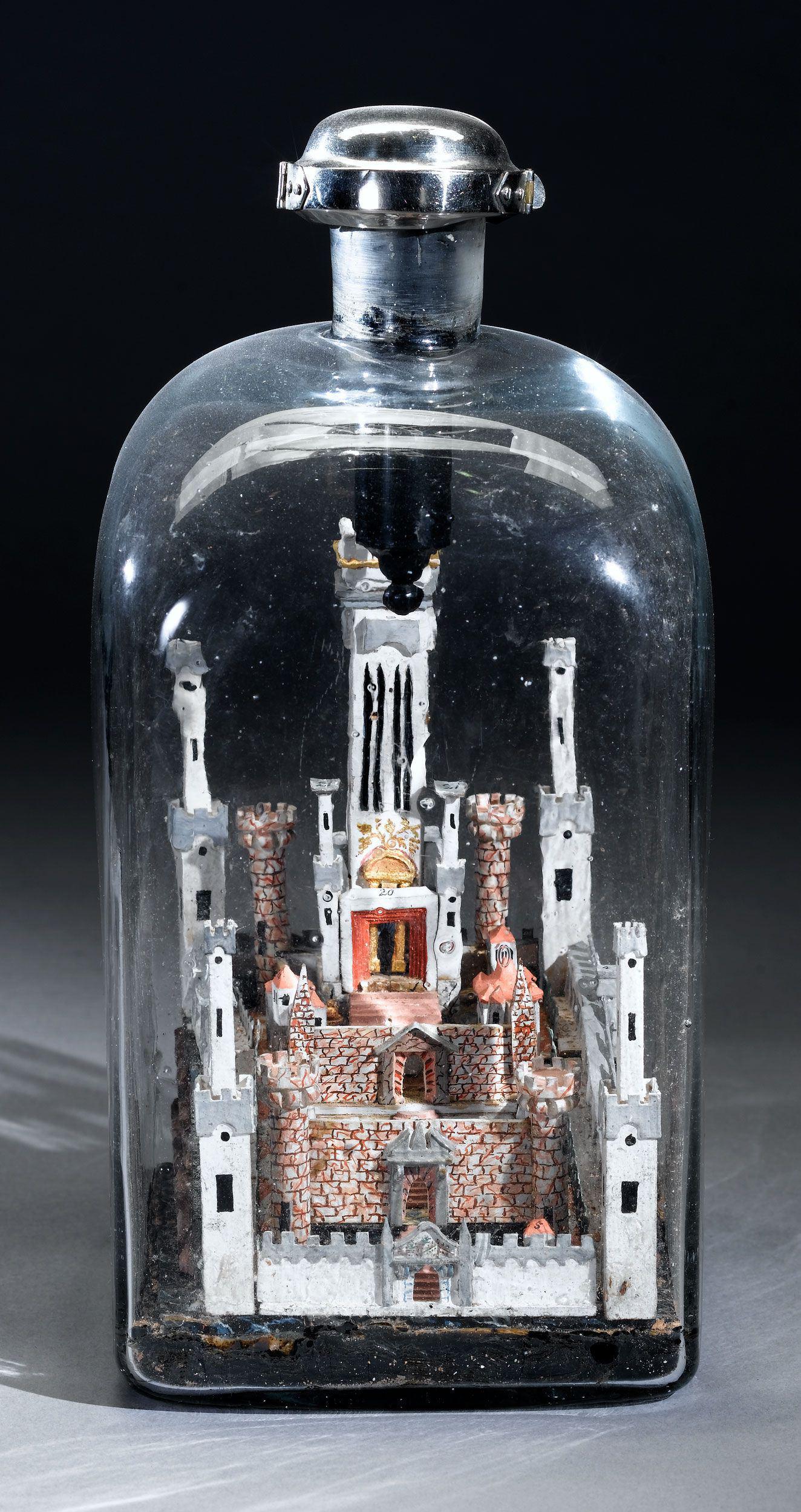
Work
Untitled (Model for Saltiel Community Center, East Talpiot, Jerusalem)
Date
c. 1975
Artist
Mathias Goeritz; Mexican, born in Danzig, 1915, died in Mexico City, 1990
Medium
Bronze
Credit Line
Purchase: Anonymous Gift, 2014-6
Mathias Goeritz’s models from the 1970s propose variations for the architectural concept of the Saltiel Community Center in Jerusalem, of which he was the designer.

Work
Untitled (Model for Saltiel Community Center, East Talpiot, Jerusalem)
Date
c. 1975
Artist
Mathias Goeritz; Mexican, born in Danzig, 1915, died in Mexico City, 1990
Medium
Paint on pressboard
Credit Line
Purchase: Anonymous Gift, 2014-5
Mathias Goeritz’s models from the 1970s propose variations for the architectural concept of the Saltiel Community Center in Jerusalem, of which he was the designer.

Work
Untitled (Model for Saltiel Community Center, East Talpiot, Jerusalem)
Date
c. 1975
Artist
Mathias Goeritz; Mexican, born in Danzig, 1915, died in Mexico City, 1990
Medium
Paint on pressboard
Credit Line
Purchase: Anonymous Gift, 2014-4
Mathias Goeritz’s models from the 1970s propose variations for the architectural concept of the Saltiel Community Center in Jerusalem, of which he was the Designer.

Work
Torah shield
Date
Between 1770 and 1780
Artist
Joachim Hübener II; German, born in about 1705, died in 1780
Place Made
Berlin
Medium
Repoussé, parcel-gilt, cast, and engraved silver and glass
Credit Line
Gift of the Danzig Jewish Community, D 150

Work
Osher
Date
2006
Artist
Lucy Puls; American, born in 1955
Medium
Cinnamon, binder, and cardboard
Credit Line
Purchase: Contemporary Judaica Acquisitions Committee Fund, 2007-10.1-5
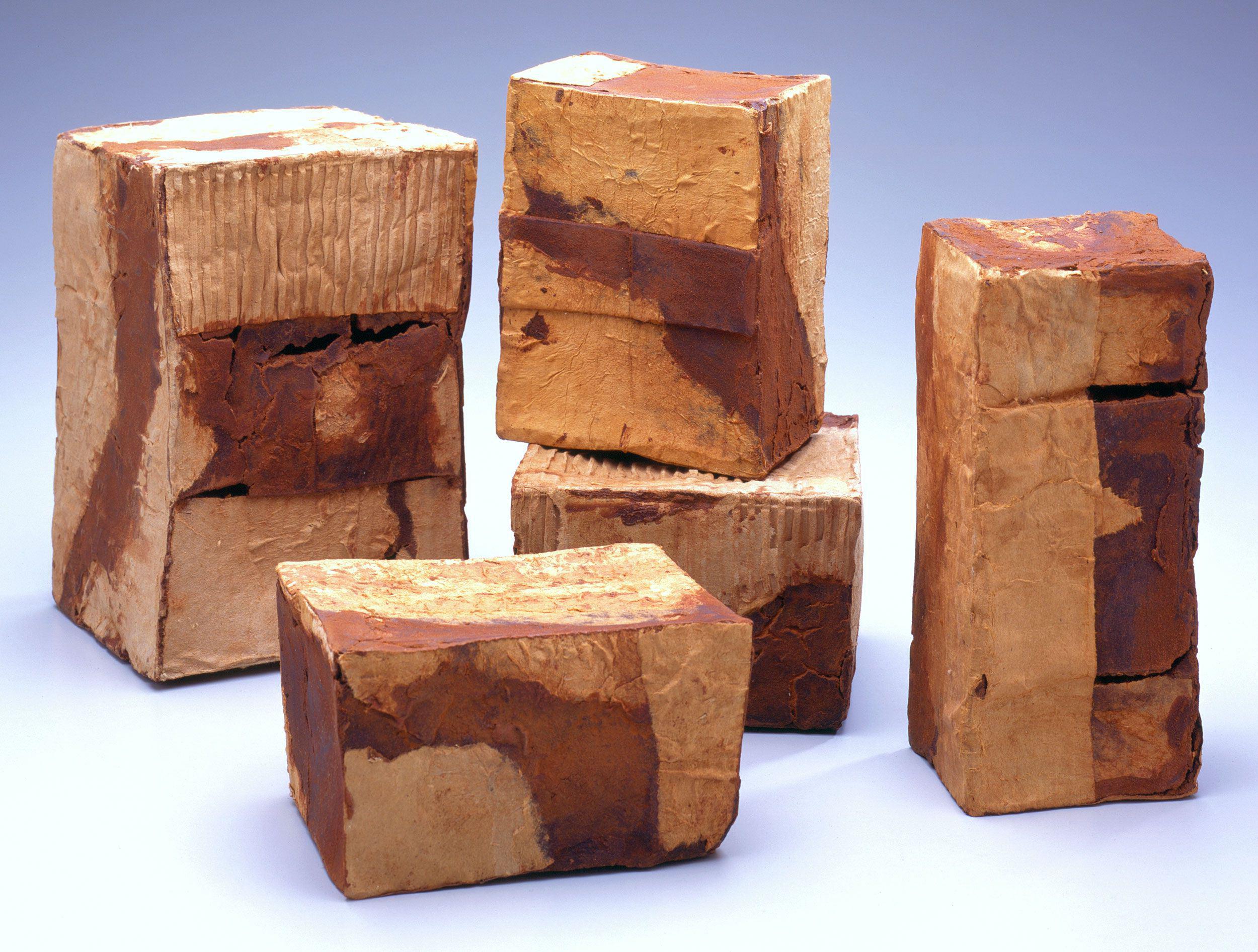
Work
Spice container
Date
Nineteenth century
Artist
Unknown
Place Made
Poland or Russian Empire
Medium
Silver
Credit Line
Gift of the Danzig Jewish Community, D 192
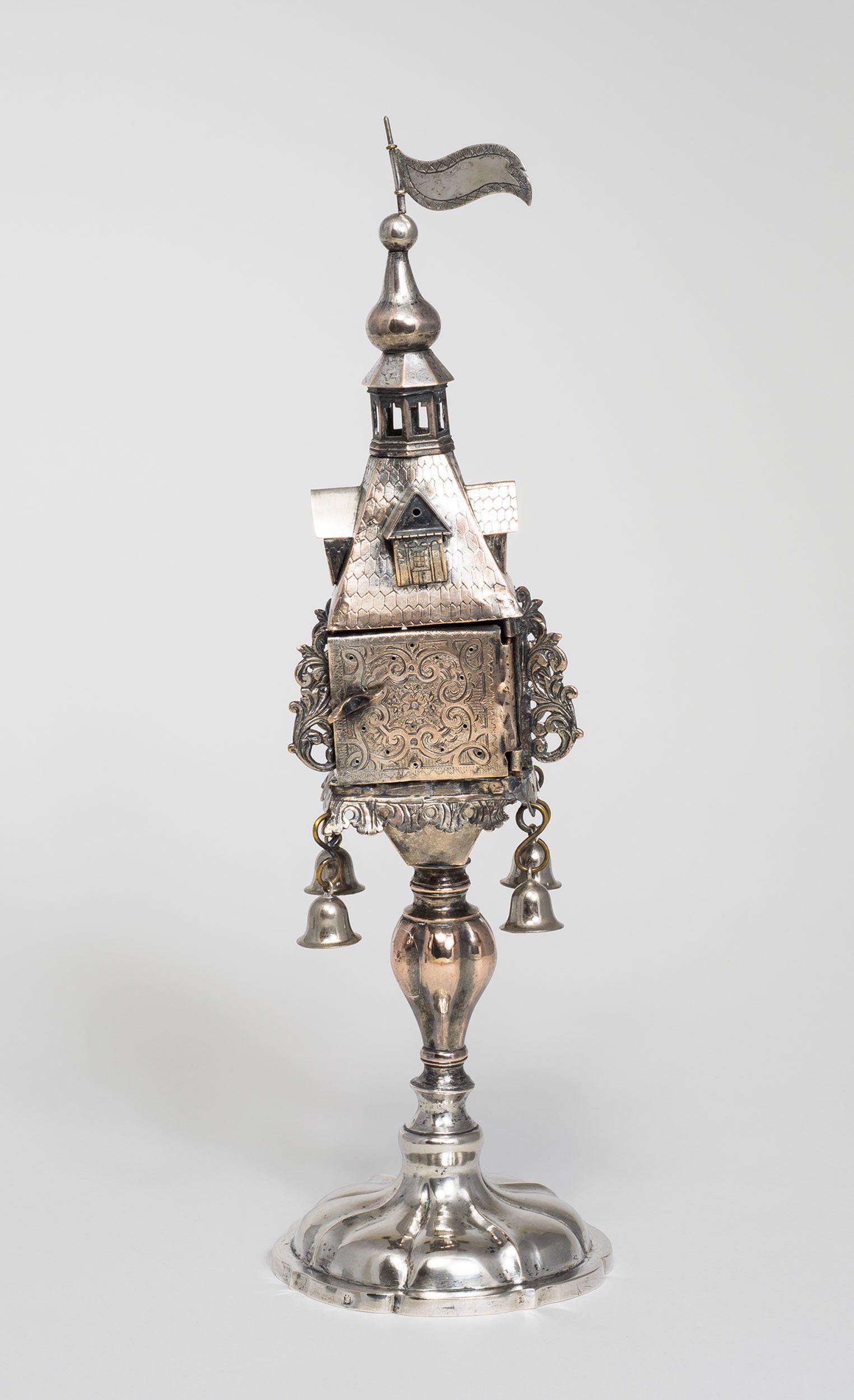
Work
Spice container
Date
c. 1880
Artist
Unknown, stamped with initials S F
Place Made
Saint Petersburg?, Russia
Medium
Silver filigree and cast silver
Credit Line
Gift of Elsie and Simon Winer in honor of their grandsons, Adam, Michael, and Eugene Winer, 1981-4

Work
Spice container
Date
Eighteenth or early nineteenth century
Artist
Unknown
Place Made
Central or Eastern Europe
Medium
Silver filigree
Credit Line
Gift of the Danzig Jewish Community, D 191
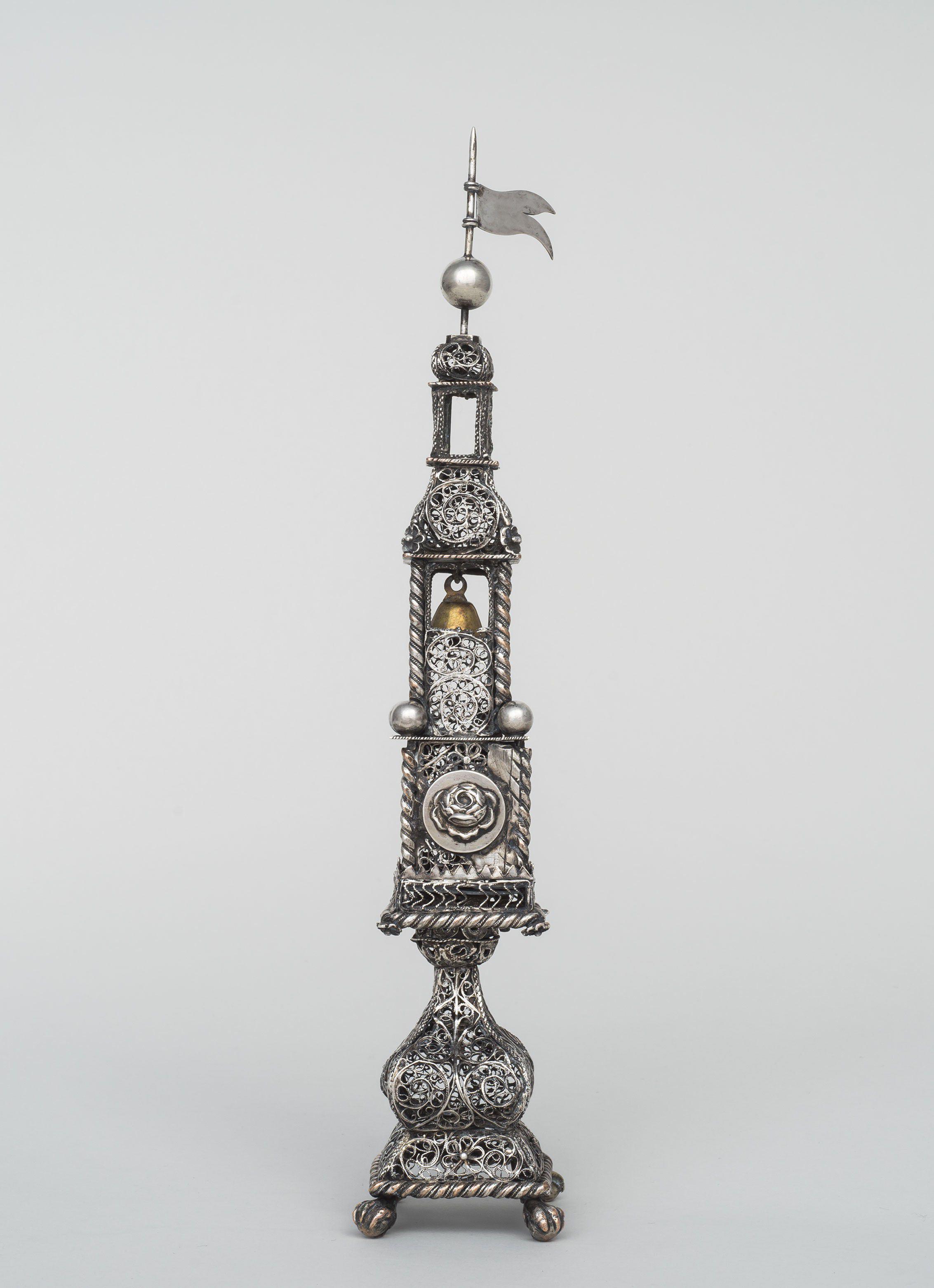
Work
Spice container
Date
Late eighteenth or early nineteenth century
Artist
Unknown
Place Made
Eastern Europe
Medium
Pierced, engraved, traced, stamped, and parcel-gilt silver
Credit Line
Gift of the Danzig Jewish Community, D 195
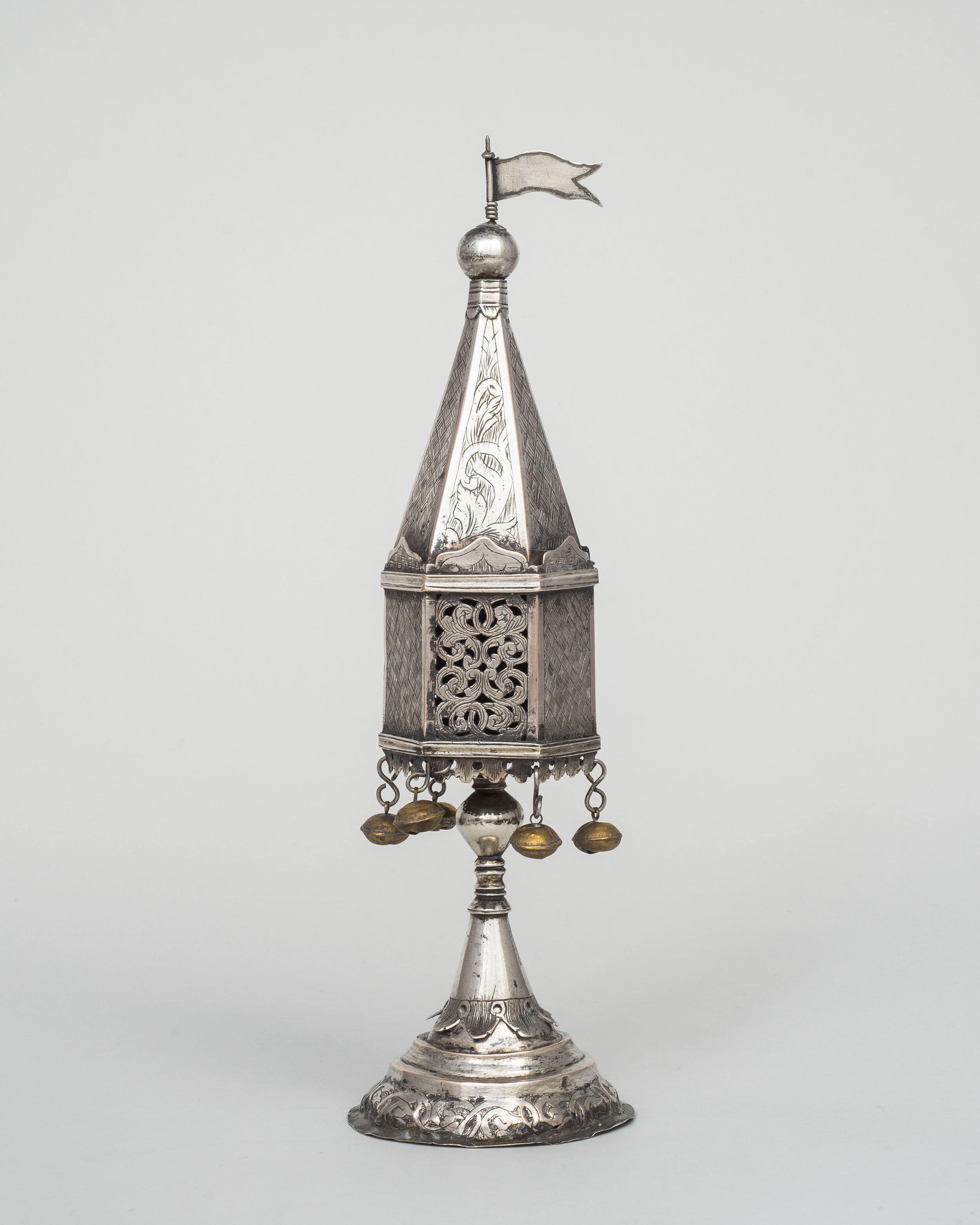
Work
Spice container
Date
Late nineteenth century?
Artist
Unknown
Place Made
Germany?
Medium
Repoussé silver with silver filigree
Credit Line
Gift of Dr. Harry G. Friedman, F 1099
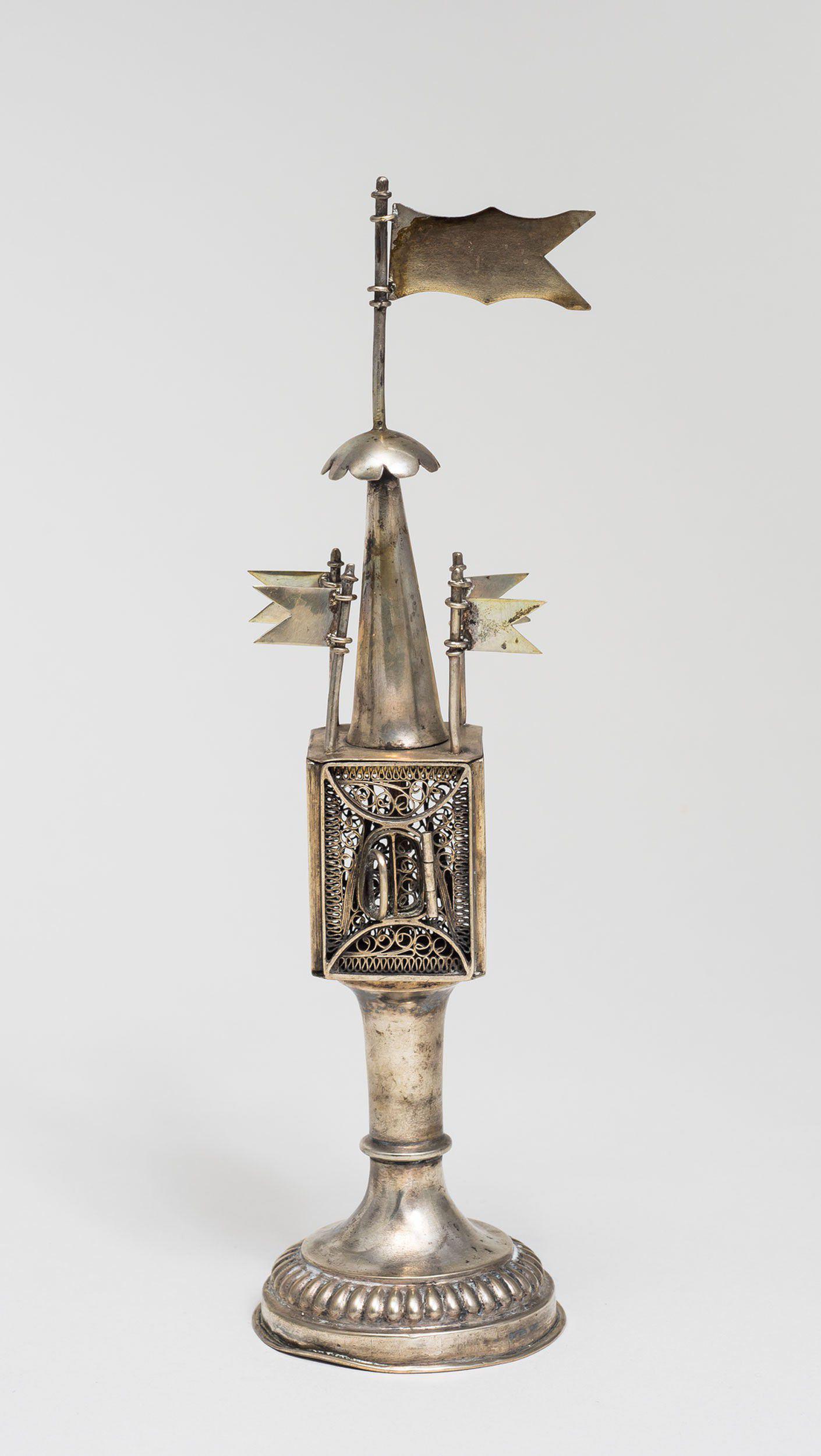
Work
Spice container
Date
Early twentieth century
Artist
Unknown
Place Made
Central Europe
Medium
Pierced silver
Credit Line
Gift of Dr. Harry G. Friedman, F 1510a
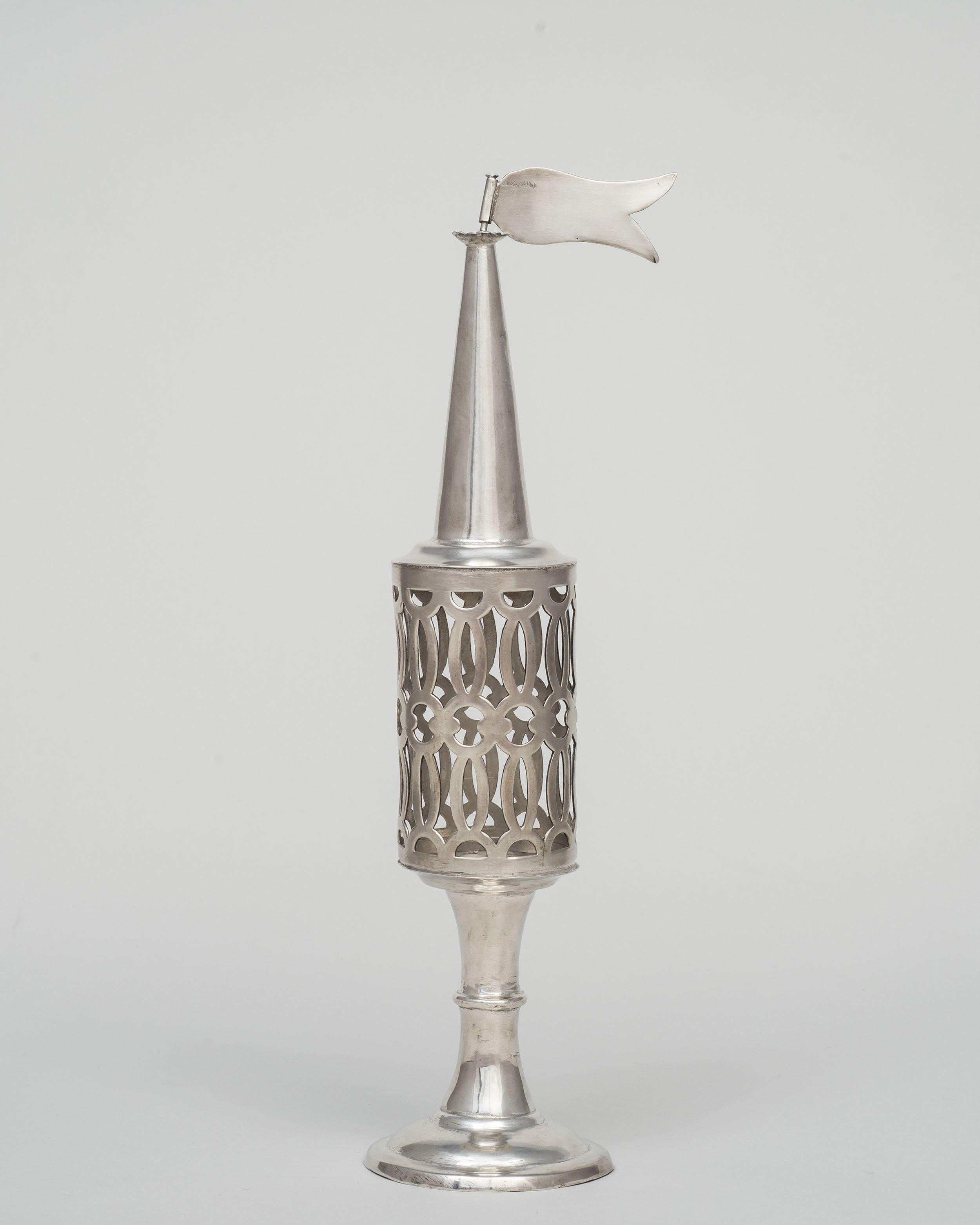
Work
Spice container
Date
Eighteenth or early nineteenth century
Artist
Unknown
Place Made
Central or Eastern Europe
Medium
Silver filigree
Credit Line
Gift of Dr. Harry G. Friedman, F 2601

Work
Spice container
Date
Second half of the nineteenth century
Artist
Unknown
Place Made
Warsaw?
Medium
Silver filigree and silver-plated copper alloy
Credit Line
Gift of the Maurice Herrmann Collection, S 405

Work
Spice container
Date
Late nineteenth or early twentieth century
Artist
Unknown
Place Made
Hanau?, Germany
Medium
Pierced and traced silver
Credit Line
Gift of Dr. Harry Friedenwald, JM 83-47

Work
Spice container
Date
Eighteenth century
Artist
Unknown
Place Made
Central or Eastern Europe
Medium
Silver filigree and parcel-gilt, cast, and engraved silver
Credit Line
Gift of Mr. B. W. Huebsch, JM 19-57

Work
Spice container
Date
Eighteenth or early nineteenth century
Artist
Unknown
Place Made
Central or Eastern Europe
Medium
Silver filigree, parcel-gilt, engraved, and cast silver with filigree, pearls, and semiprecious stones or glass
Credit Line
Gift of Dr. Harry G. Friedman, F 5318
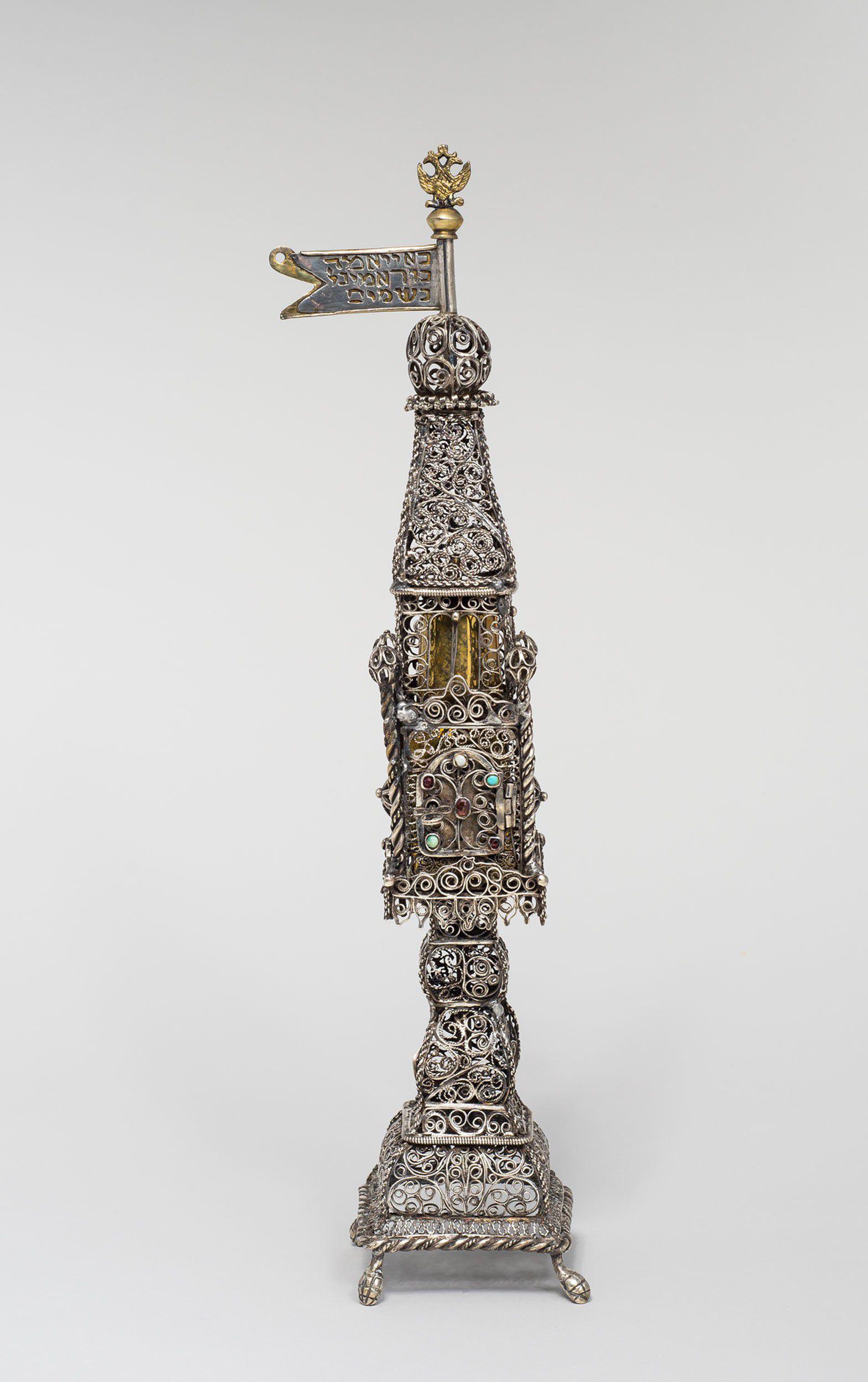
Work
Spice container
Date
1894
Artist
Unknown
Place Made
Possibly Warsaw or the United States
Medium
Silver filigree and pierced and repoussé silver
Credit Line
Gift of Dr. Harry G. Friedman, F 320

Work
Spice container
Date
Eighteenth century?
Artist
Unknown
Place Made
Germany?
Medium
Repoussé, pierced, cast, and engraved silver
Credit Line
Gift of Dr. Harry G. Friedman, F 2962

Work
Spice container
Date
1883–1925
Artist
Buch Brothers
Russian, around 1893–around 1915
Place Made
Warsaw
Medium
Pierced, die-stamped, and parcel-gilt silver
Credit Line
Gift of Dr. Harry G. Friedman, F 370

Work
Spice container
Date
Late nineteenth–early twentieth century
Artist
Unknown
Place Made
Eastern Europe
Medium
Silver filigree and engraved and formerly parcel-gilt silver
Credit Line
Gift of Dr. Harry G. Friedman, F 405

Work
Spice container
Date
Late nineteenth or early twentieth century
Artist
Unknown
Place Made
Hanau?, Germany
Medium
Repoussé, pierced, and traced silver
Credit Line
Gift of Dr. Harry G. Friedman, F 495
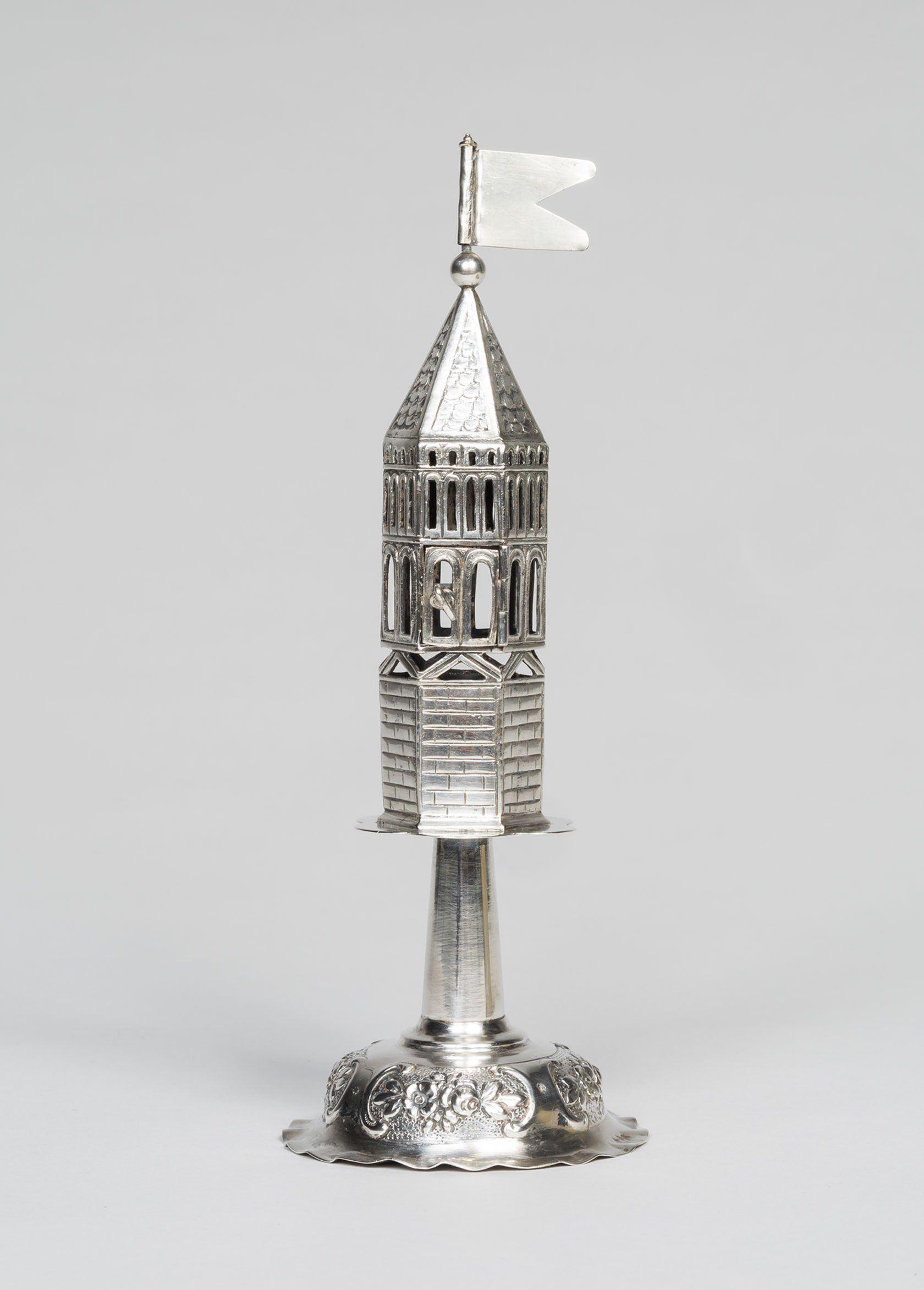
Work
Spice container
Date
Between 1805 and 1808
Artist
Paulus Friedrich Bierfreund; German, born in Nuremberg, 1764, died in 1816
Place Made
Nuremberg, Germany
Medium
Pierced, chased, and repoussé silver
Credit Line
Gift of Dr. Harry G. Friedman, F 334
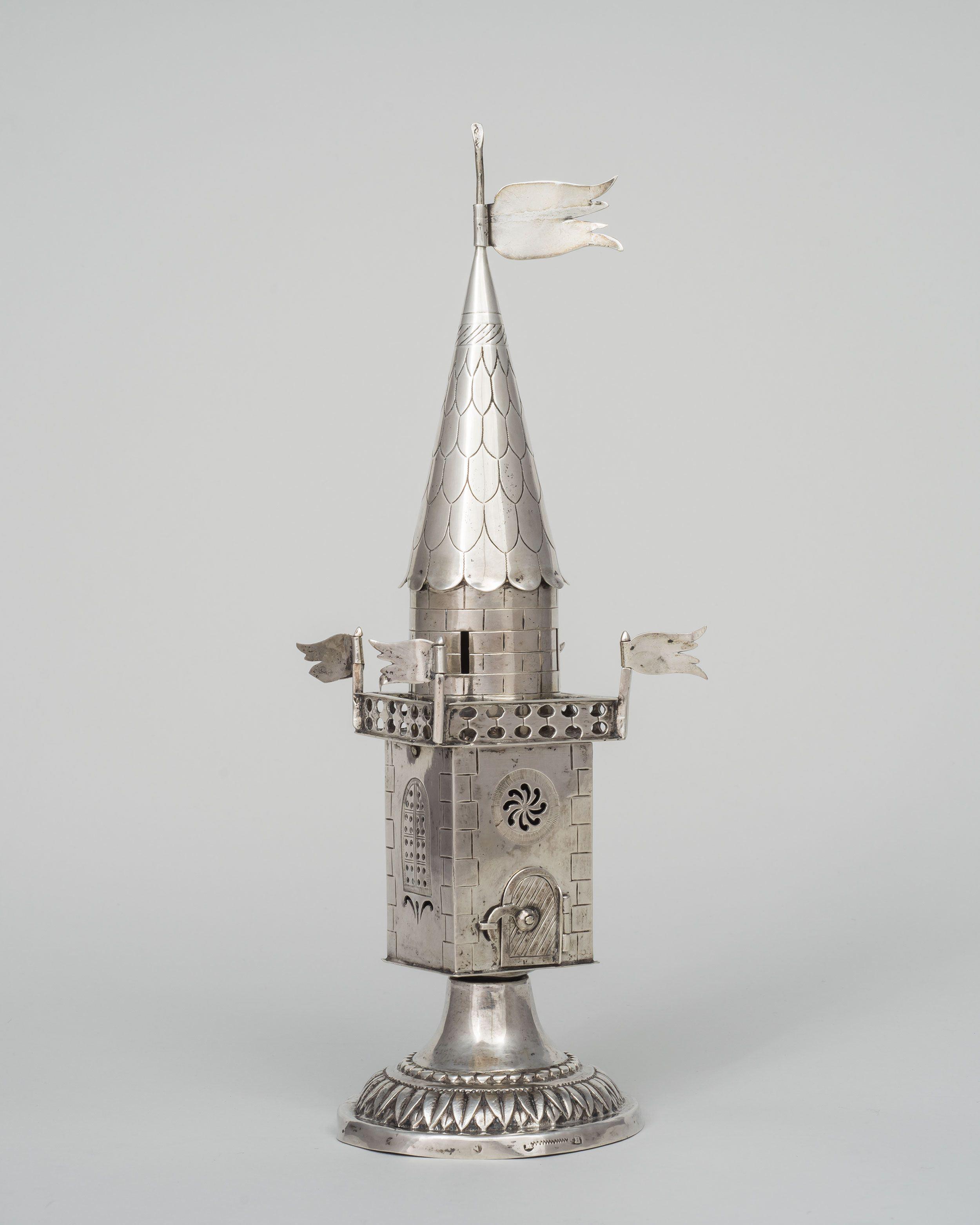
Work
Spice container
Date
Late nineteenth or early twentieth century
Artist
Unknown
Place Made
Hanau?, Germany
Medium
Silver
Credit Line
Gift of Dr. Harry G. Friedman, F 338

Work
Spice container
Date
Late nineteenth or early twentieth century
Artist
Unknown
Place Made
Possibly Warsaw or the United States
Medium
Silver filigree and engraved silver
Credit Line
Gift of Dr. Harry G. Friedman, F 355
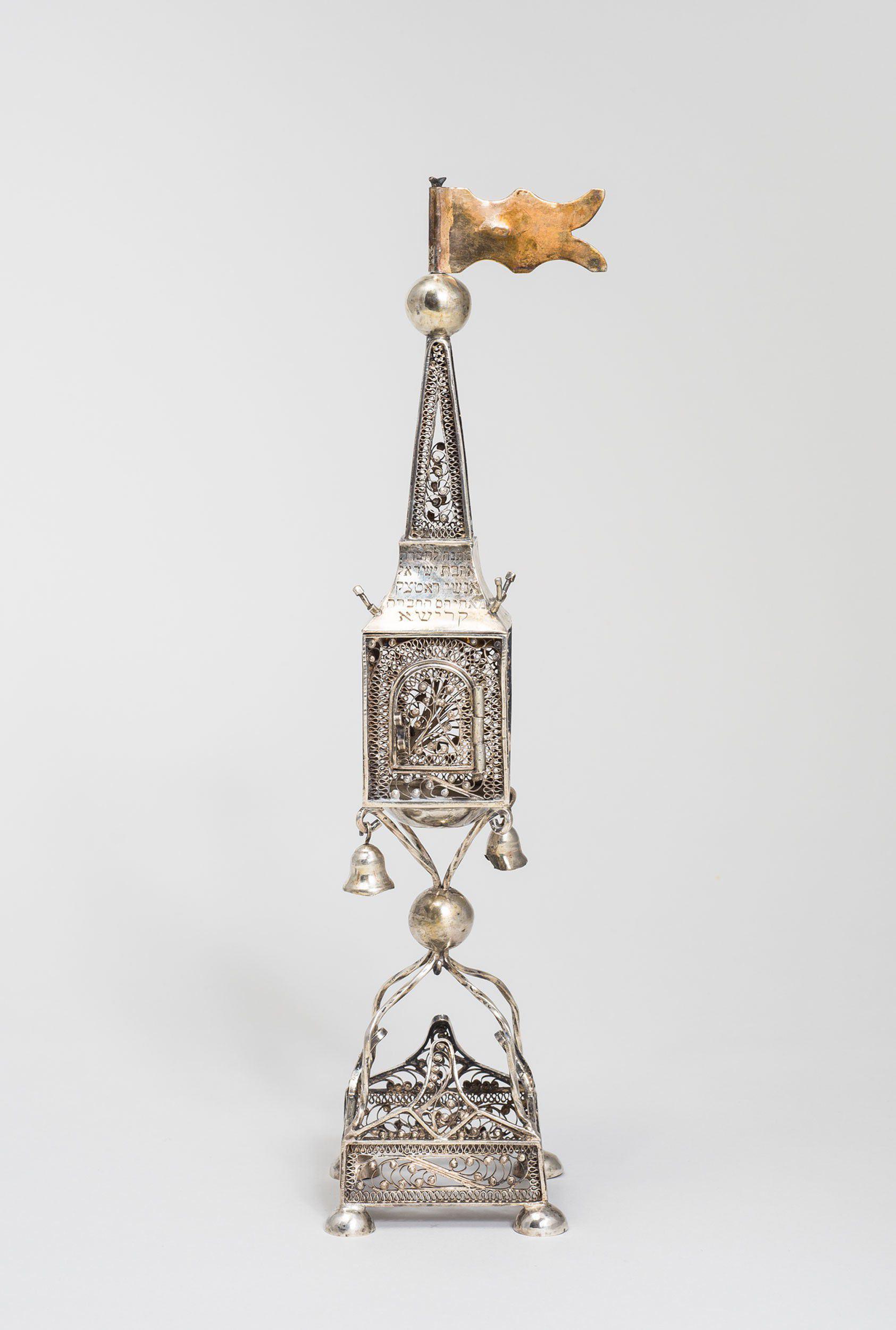
Work
Spice container
Date
Late nineteenth or early twentieth century
Artist
Unknown; American, stamped with the maker’s initials H. L.
Place Made
United States
Medium
Silver filigree
Credit Line
Gift of Dr. Harry G. Friedman, F 374
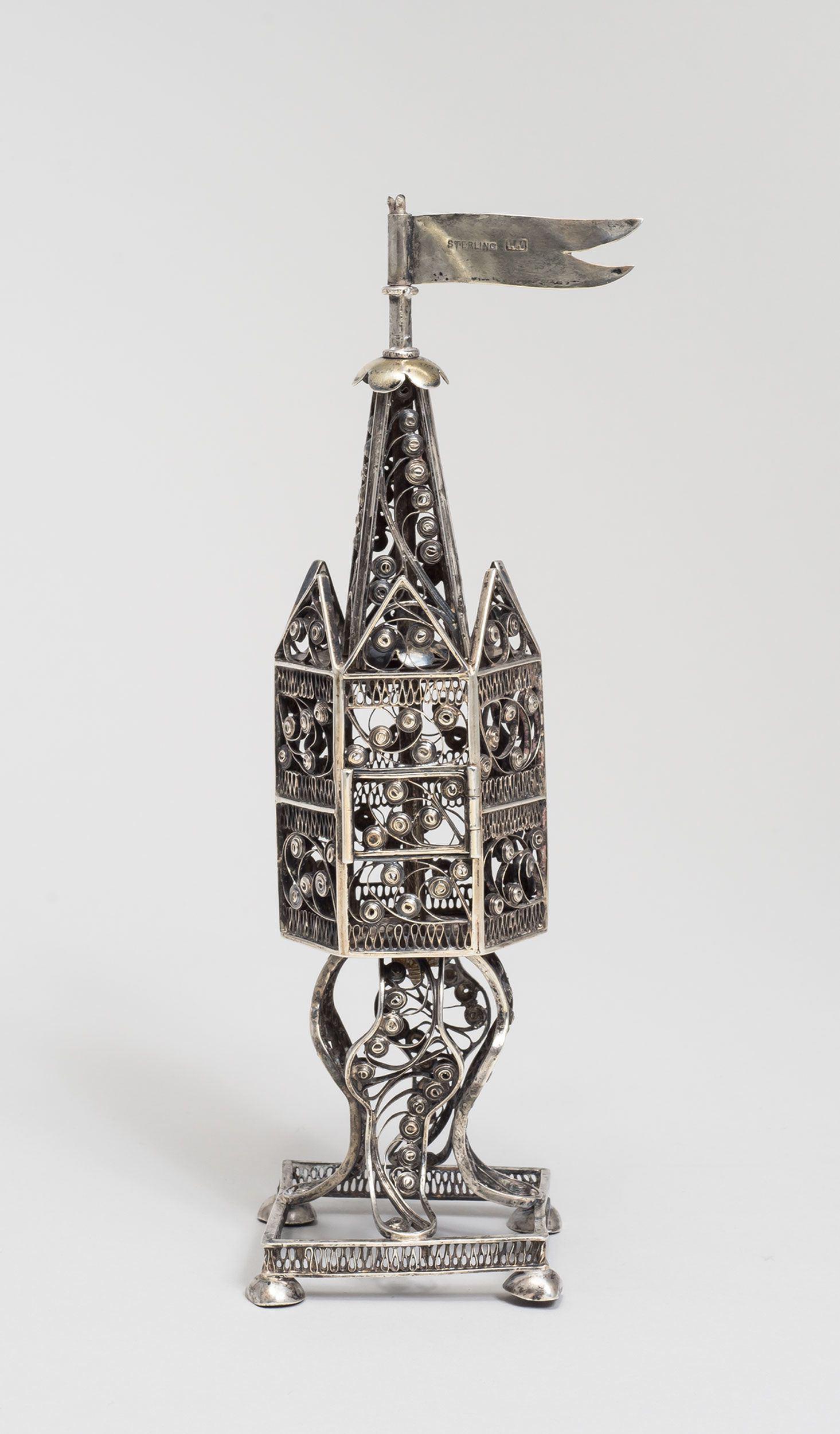
Work
Torah finials
Date
Between 1804 and 1815
Artist
Unknown
Place Made
Berlin
Medium
Chased, pierced, cast, and parcel-gilt silver
Credit Line
Gift of Robert I. Wishnik, JM 30-57a-b
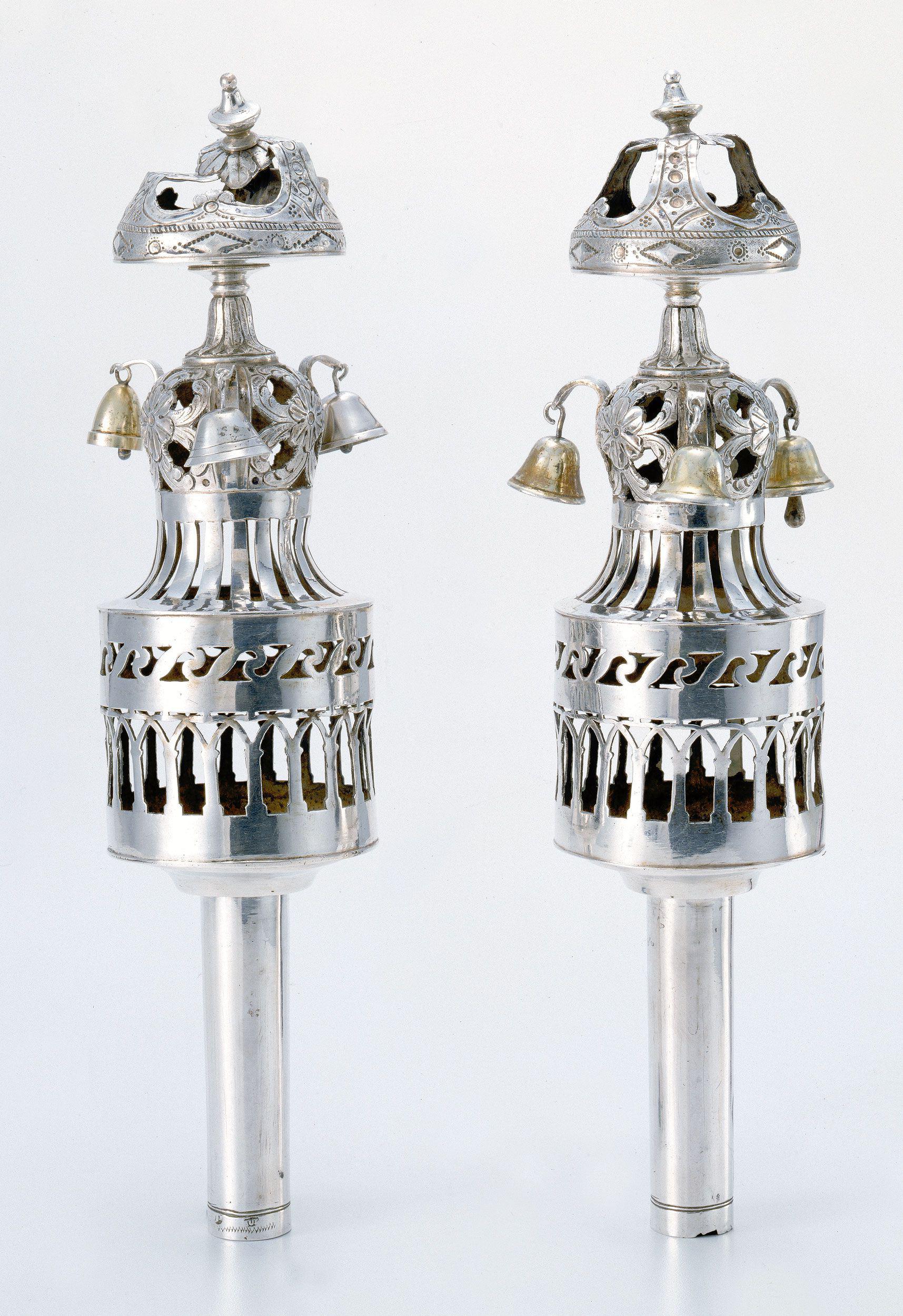
Work
Torah finials
Date
Early nineteenth century
Artist
Unknown
Place Made
Germany?
Medium
Repoussé and cast silver and glass
Credit Line
Gift of the Danzig Jewish Community, D 182a-b

Work
Torah finials
Date
Early twentieth century
Artist
Unknown
Place Made
Israel?
Medium
Die-stamped, chased, and gilt silver with filigree and glass
Credit Line
Gift of Max Warburg, S 1137a-b
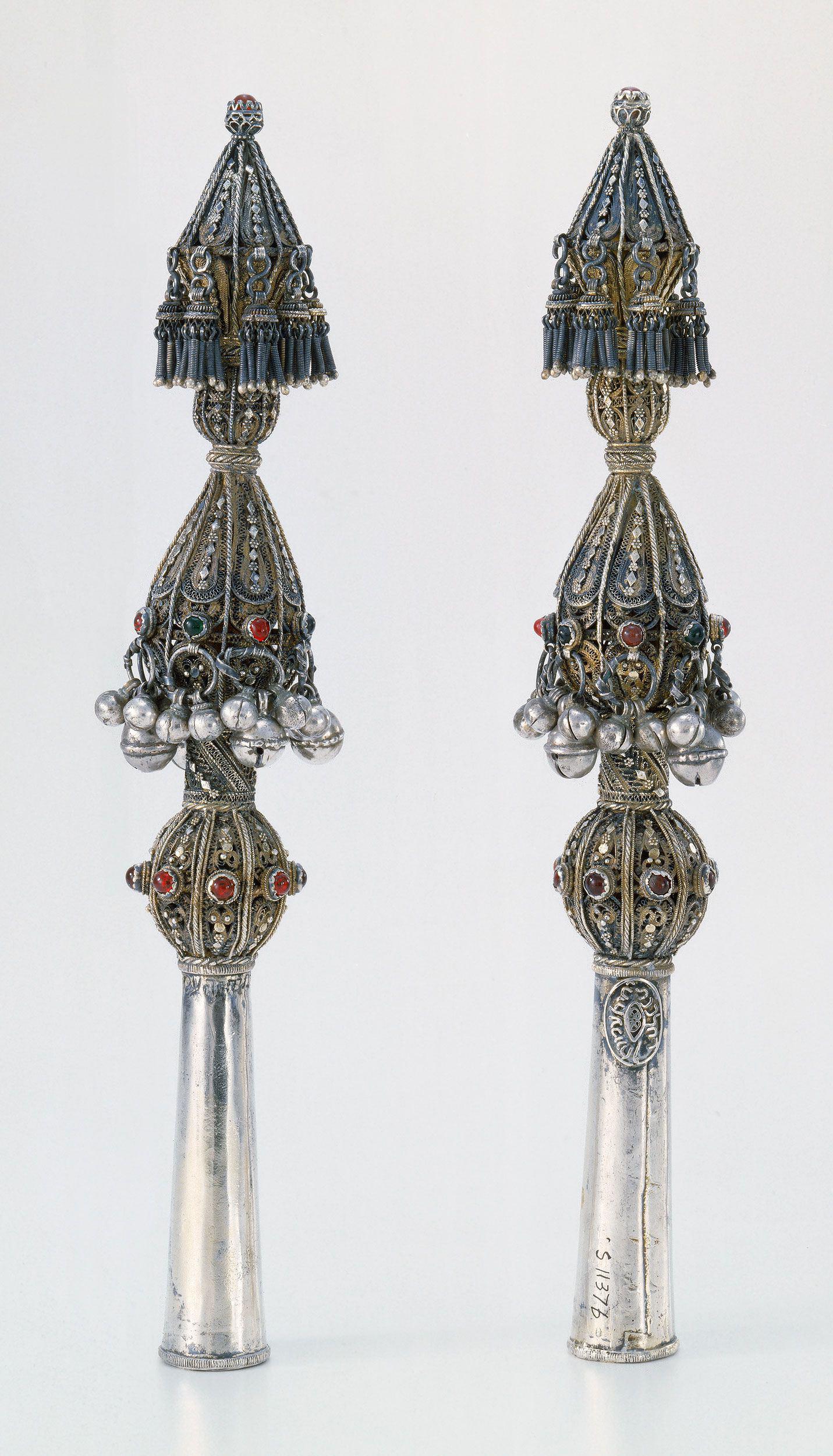
Work
Torah finials
Date
Late nineteenth century
Artist
Unknown
Place Made
Tunisia
Medium
Carved and gessoed wood, paint, and traces of gilt or bronzing
Credit Line
U 7487a-b

Work
Torah staves
Date
Late nineteenth or early twentieth century
Artist
Unknown
Place Made
Eastern Europe
Medium
Wood and bone
Credit Line
U 9554a-b
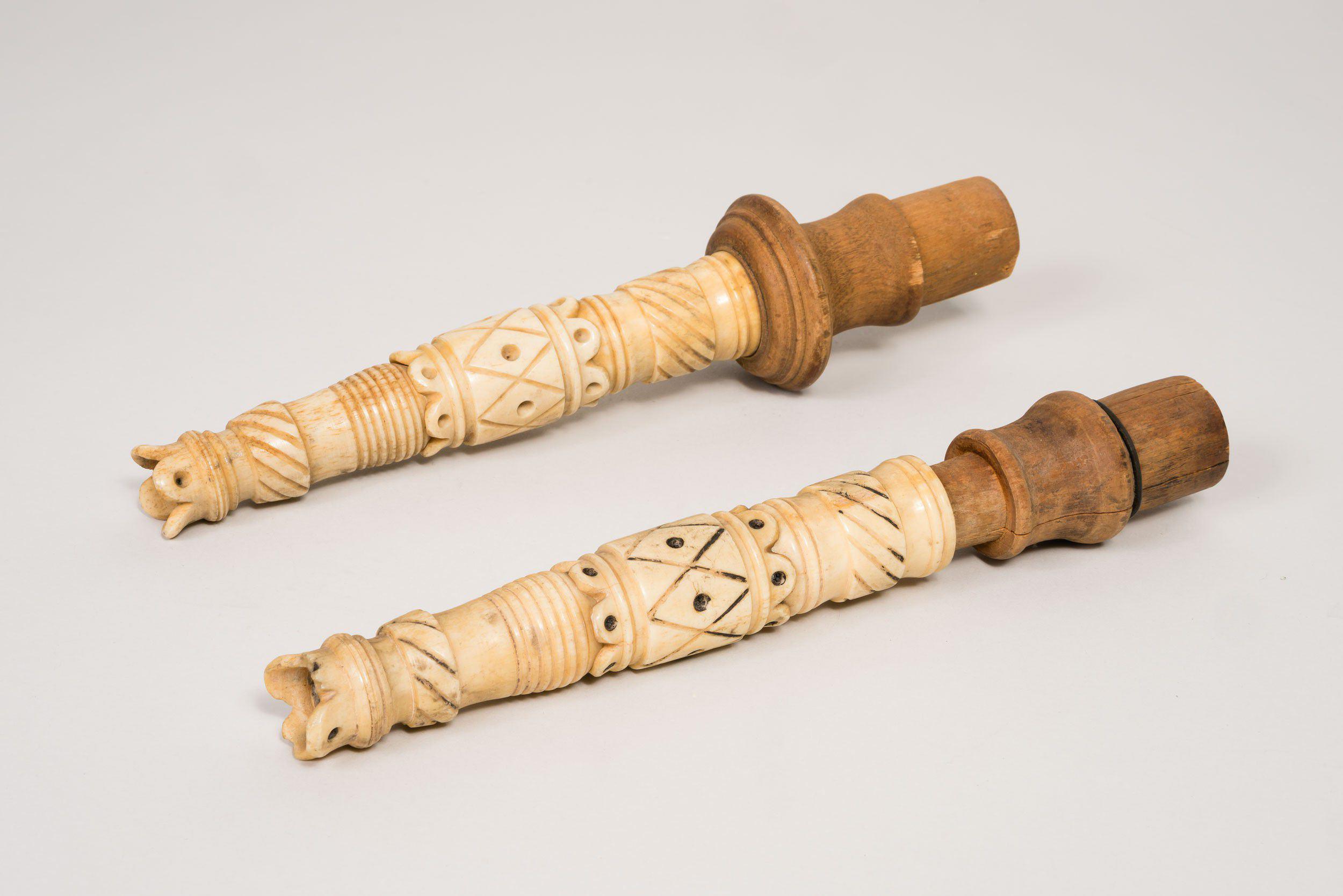
Work
Torah staves
Date
1923–24
Artist
Unknown
Place Made
Eastern Europe
Medium
Silver-plated, cast, and chased copper alloy and wood
Credit Line
U 9582a-b

Work
Torah stave
Date
Between c. 1875 and 1939
Artist
Unknown
Place Made
Eastern Europe
Medium
Wood, mother-of-pearl inlay, and chased silver?
Credit Line
U 9593

Work
Torah staves
Date
Early twentieth century
Artist
Unknown
Place Made
Eastern Europe
Medium
Wood, bone, glass, and ink on parchment
Credit Line
U 9581a-b
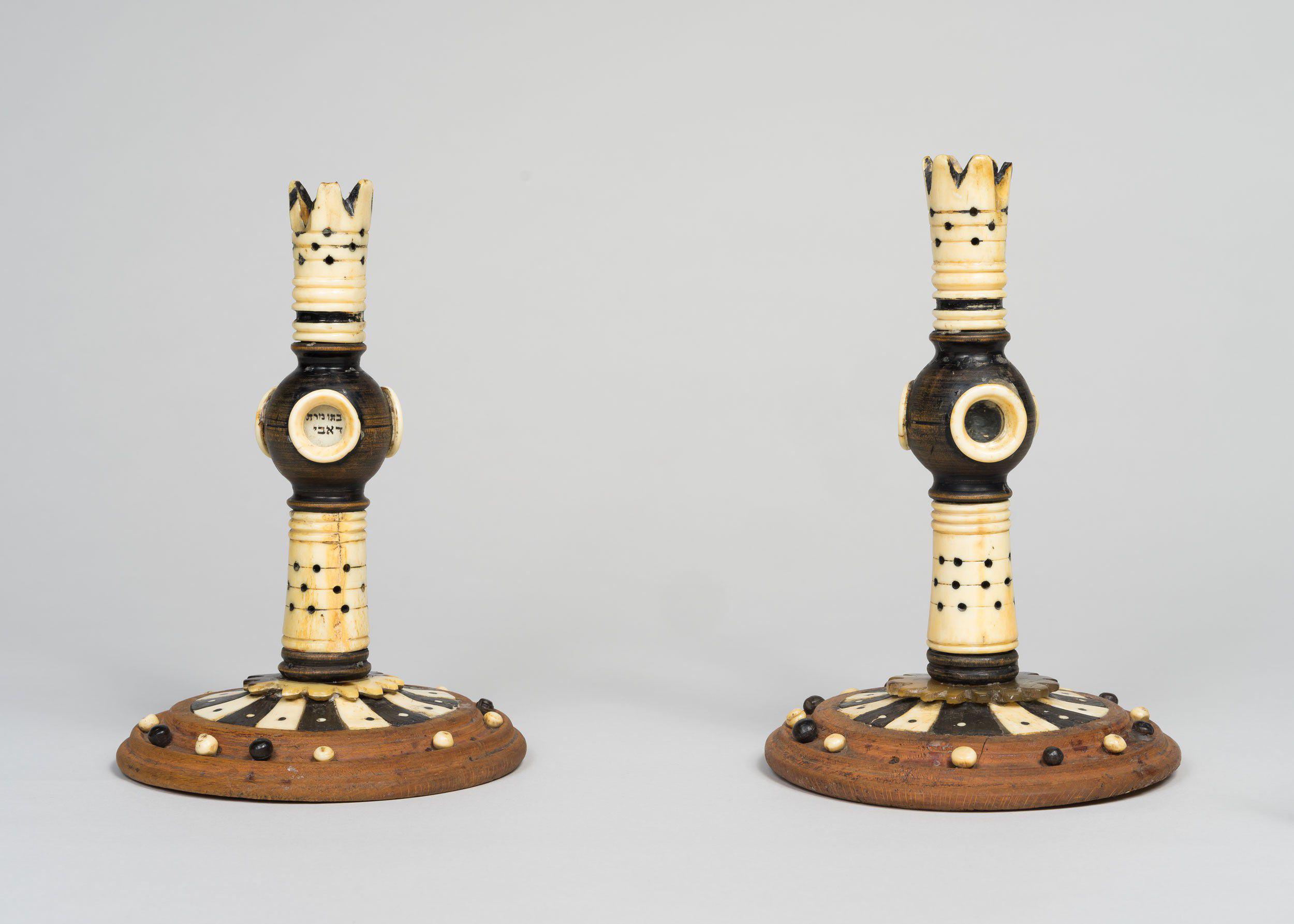
Work
Torah stave
Date
Early twentieth century
Artist
Unknown
Place Made
Eastern Europe
Medium
Wood, bone, and glass, with ink on paper
Credit Line
U 8772
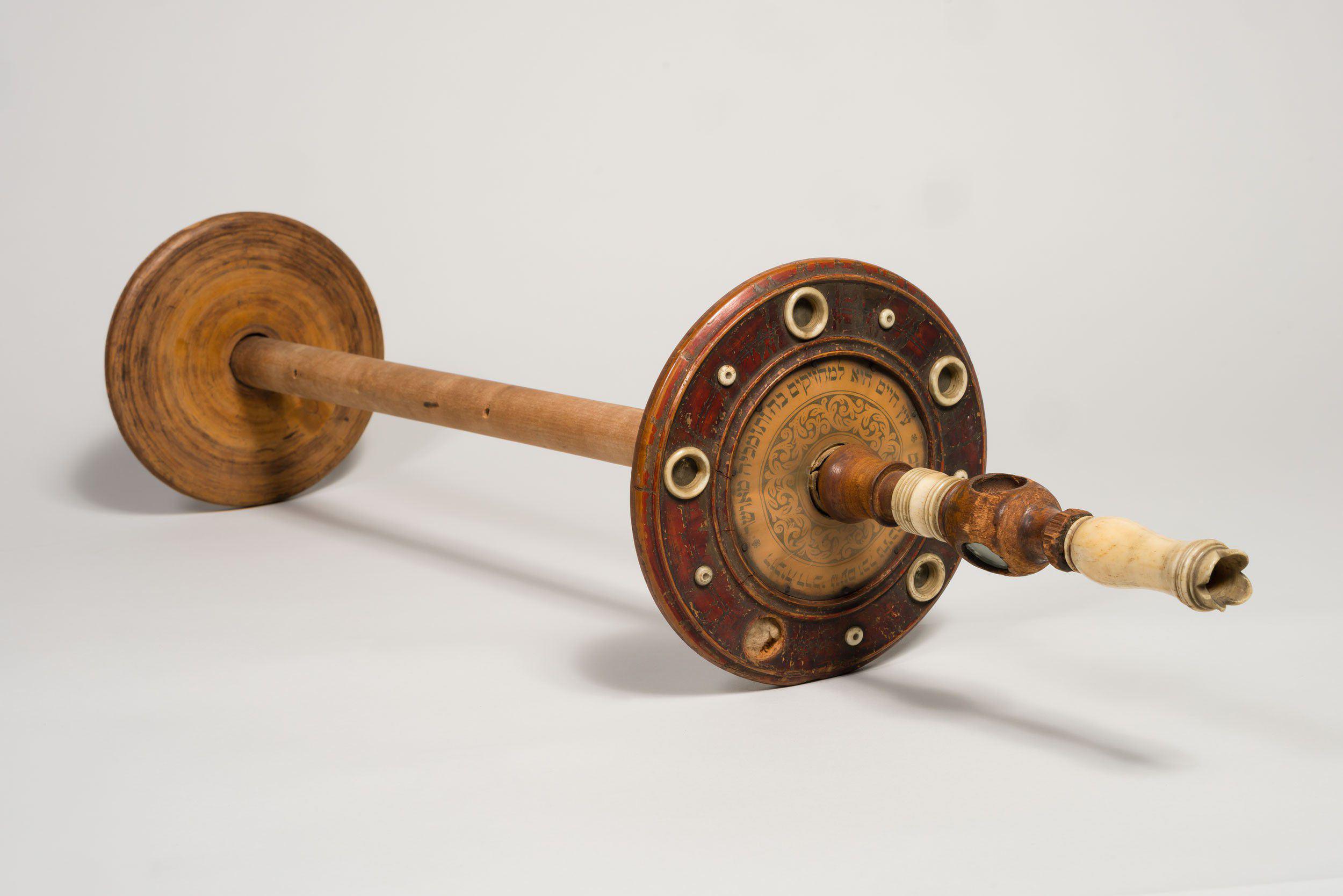
Work
Spatula, possibly for cosmetics
Date
Second or first millennium BCE
Artist
Unknown
Place Made
Israel?
Medium
Bone
Credit Line
Gift of the Betty and Max Ratner Collection, 1981-114

Work
Netting bobbin
Date
Between 900 and 586 BCE
Artist
Unknown
Place Made
Israel
Medium
Carved, punched, and drilled bone
Credit Line
Gift of the Betty and Max Ratner Collection, 1981-220
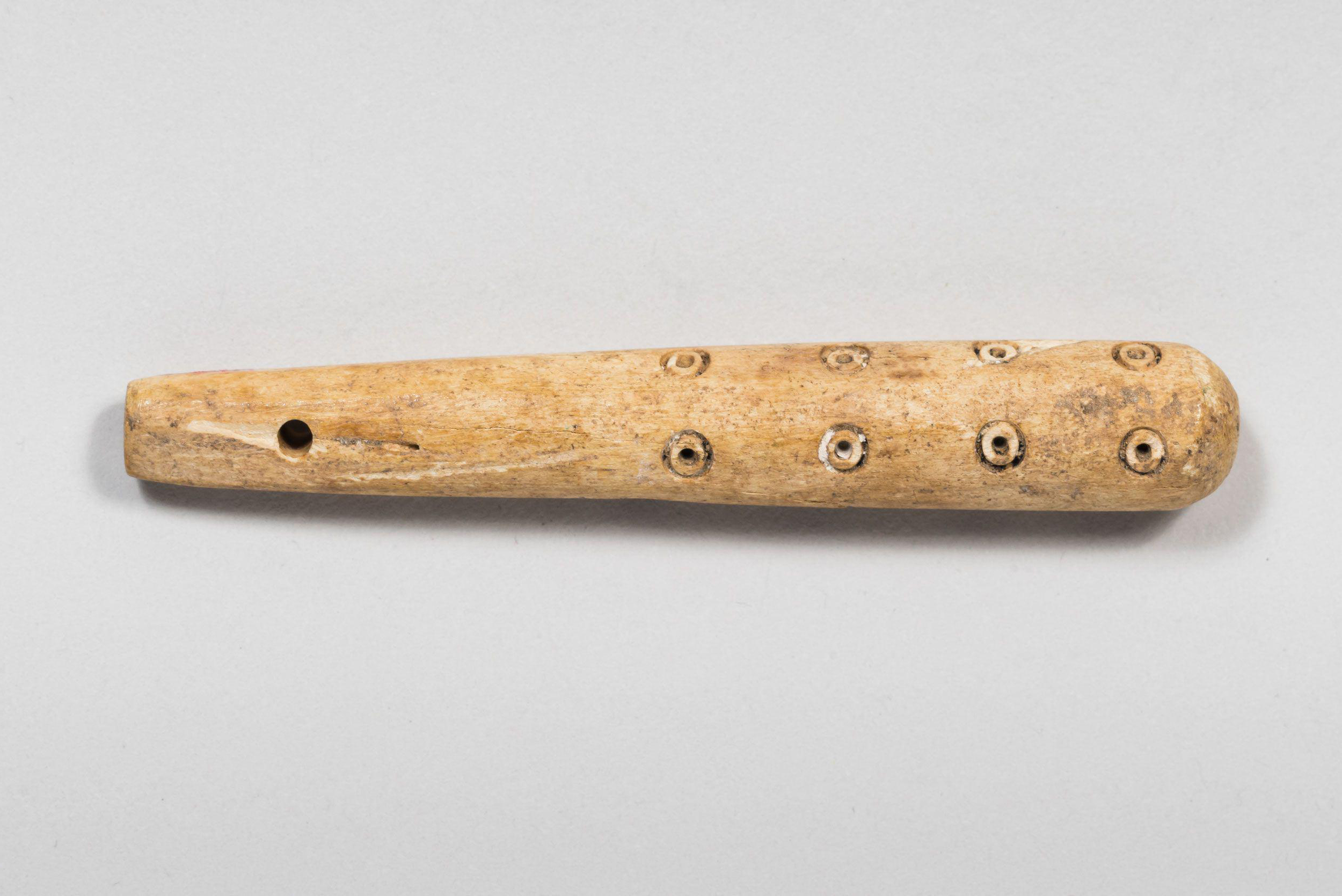
Work
Stanhope microphotographic viewer with the Decalogue
Date
Late nineteenth or early twentieth century
Artist
Unknown
Place Made
Europe or the United States
Medium
Ivory and ink printed on paper
Credit Line
Gift of Harry Lang Strauss, S 774
This miniature viewer contains a microphotograph of the Ten Commandments.

Work
Spoon
Date
Between the first and fourth century CE
Artist
Unknown
Place Made
Eastern Mediterranean
Medium
Bone
Credit Line
Gift of Bernard and Tzila Weiss, 1994-658
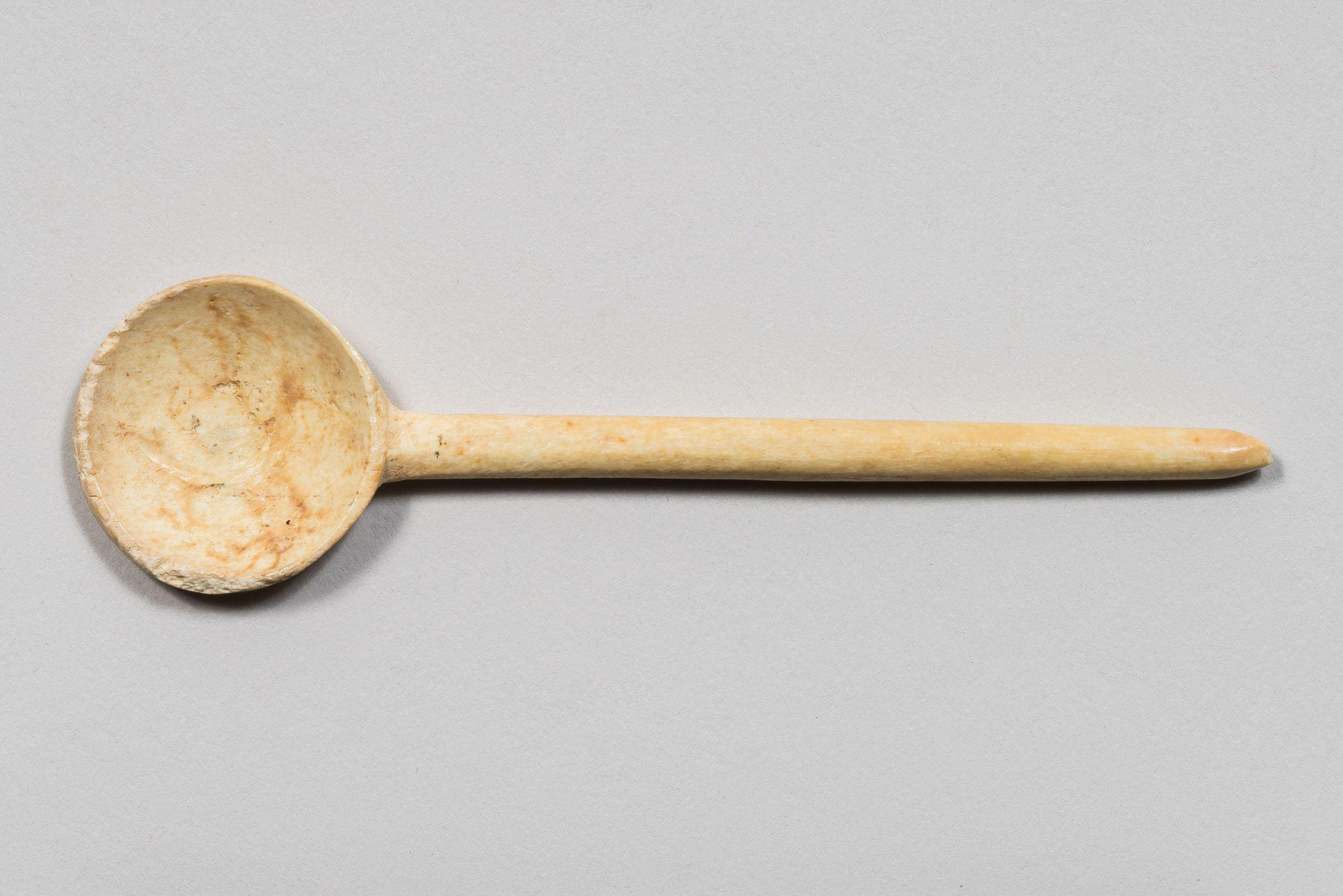
Work
Spoon
Date
Between the first century BCE and second century CE
Artist
Unknown
Place Made
Israel
Medium
Incised and drilled bone or ivory
Credit Line
Gift of Bernard and Tzila Weiss, 1994-661

Work
Box
Date
Between 1500 and 1200 BCE
Artist
Unknown
Place Made
Israel
Medium
Drilled ivory
Credit Line
Gift of Bernard and Tzila Weiss, 1994-666a-b

Work
New Year’s greeting
Date
1910
Artist
Happy Jack (Angokwazhuk); Inupiaq, born in Alaska, about 1870, died in 1918
Place Made
Nome, Alaska
Medium
Engraved walrus tusk with inset gold
Credit Line
Gift of the Kanofsky Family in memory of Minnie Kanofsky, 1984-71
This New Year greeting was made with portraits of the senders.

Work
Letter opener
Date
Late nineteenth or early twentieth century
Artist
Unknown
Place Made
India
Medium
Ivory
Credit Line
Anonymous Gift, 1985-19
This letter opener belonged to the psychoanalyst Anna Freud, daughter of Sigmund. It is one of several mementos of the Freud family owned by the Jewish Museum.

Work
Box or furniture inlays
Date
Between 2000 and 1550 BCE
Artist
Unknown
Place Made
Gaza
Medium
Incised and drilled bone
Credit Line
Purchase: Archaeology Acquisition Fund, JM 12-73.468
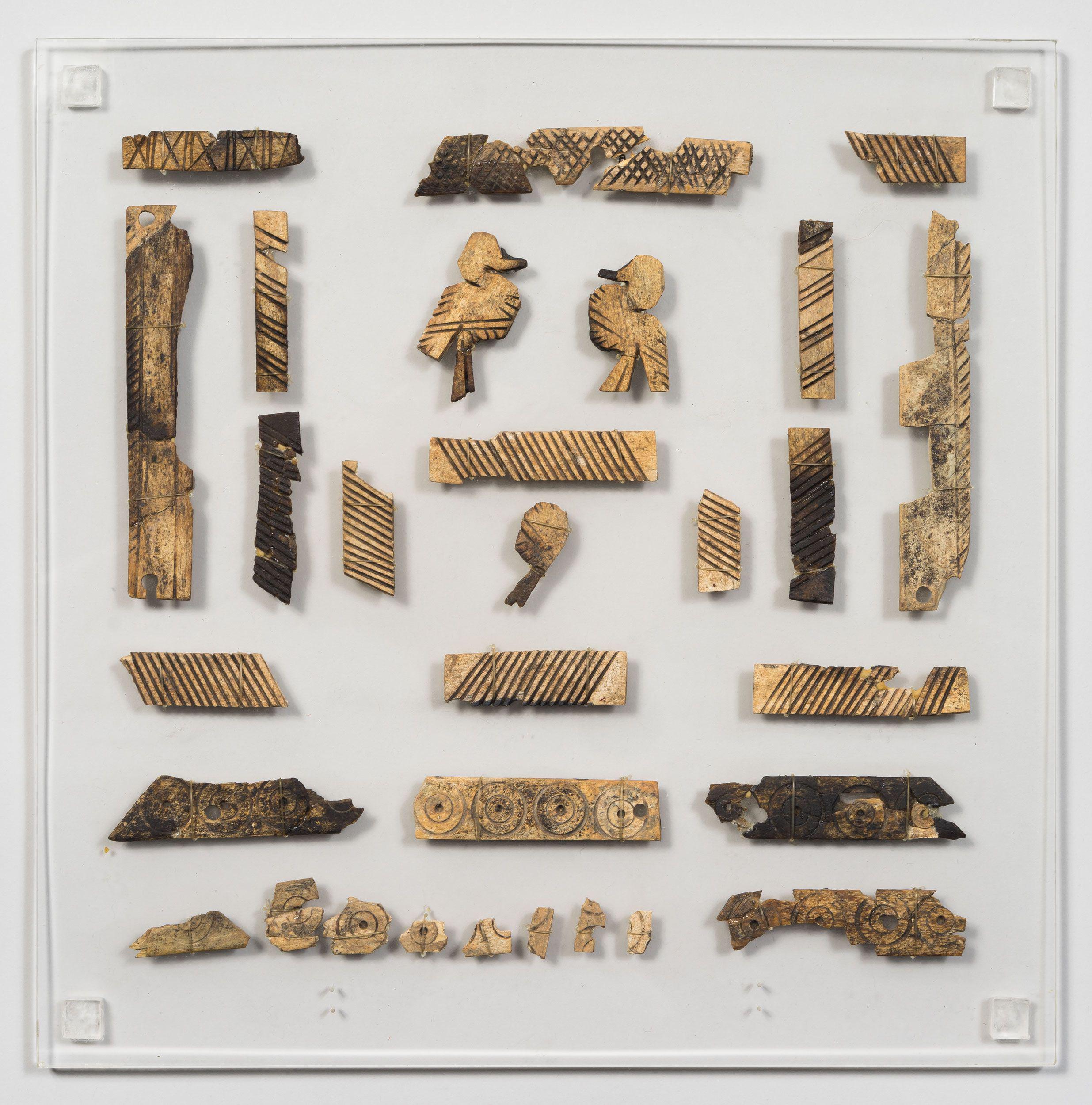
Work
Havdalah cup
Date
Nineteenth century?
Artist
Unknown
Place Made
Europe?
Medium
Lathe-turned and traced horn
Credit Line
Gift of Samuel and Lucille Lemberg, JM 56-61
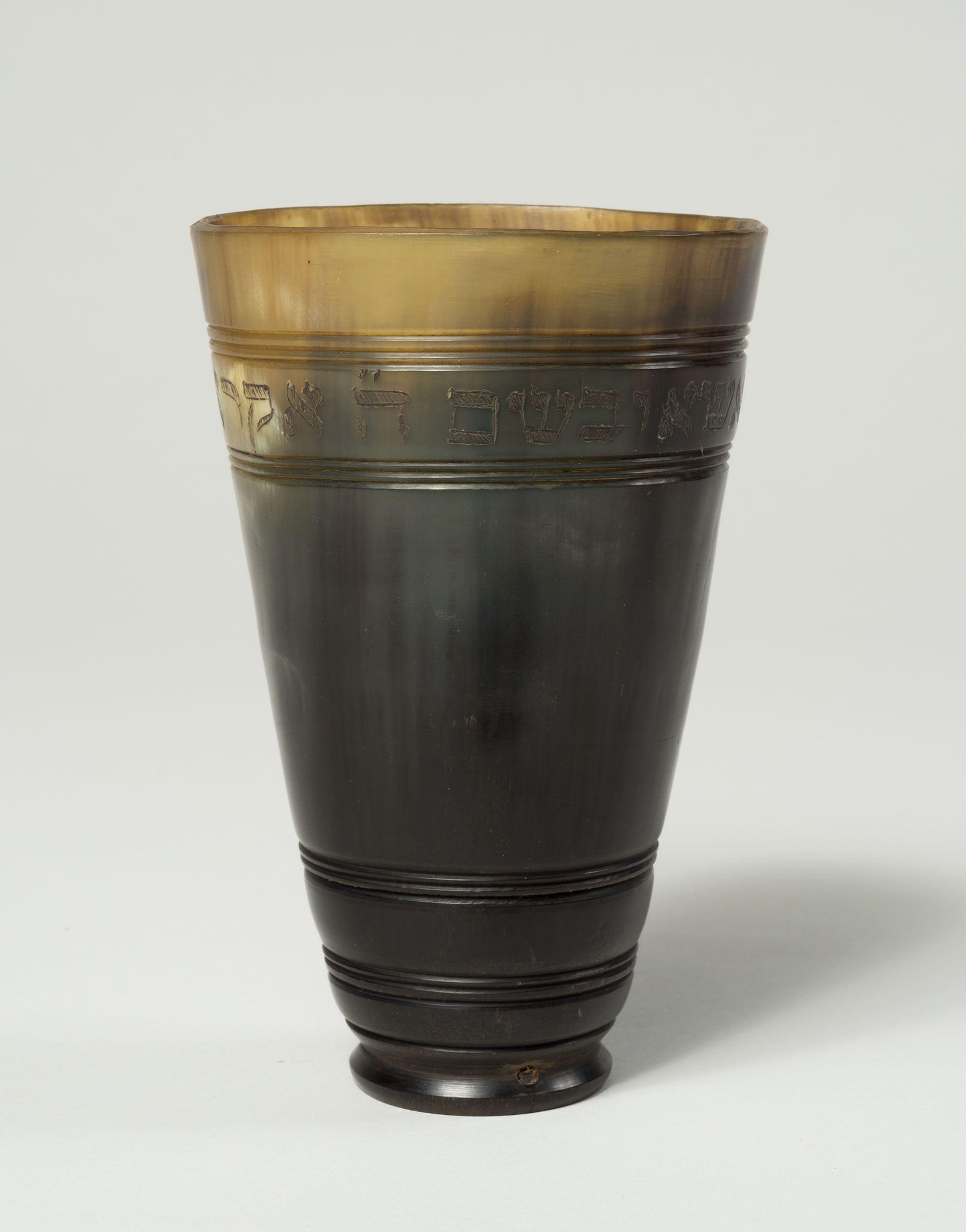
Work
Souvenir shell
Date
Between 1900 and 1941
Artist
Unknown
Place Made
United States or Palestine
Medium
Acid-etched cowrie shell
Credit Line
Gift of Dr. Harry G. Friedman, F 666
The Ten Commandments are inscribed in Hebrew.
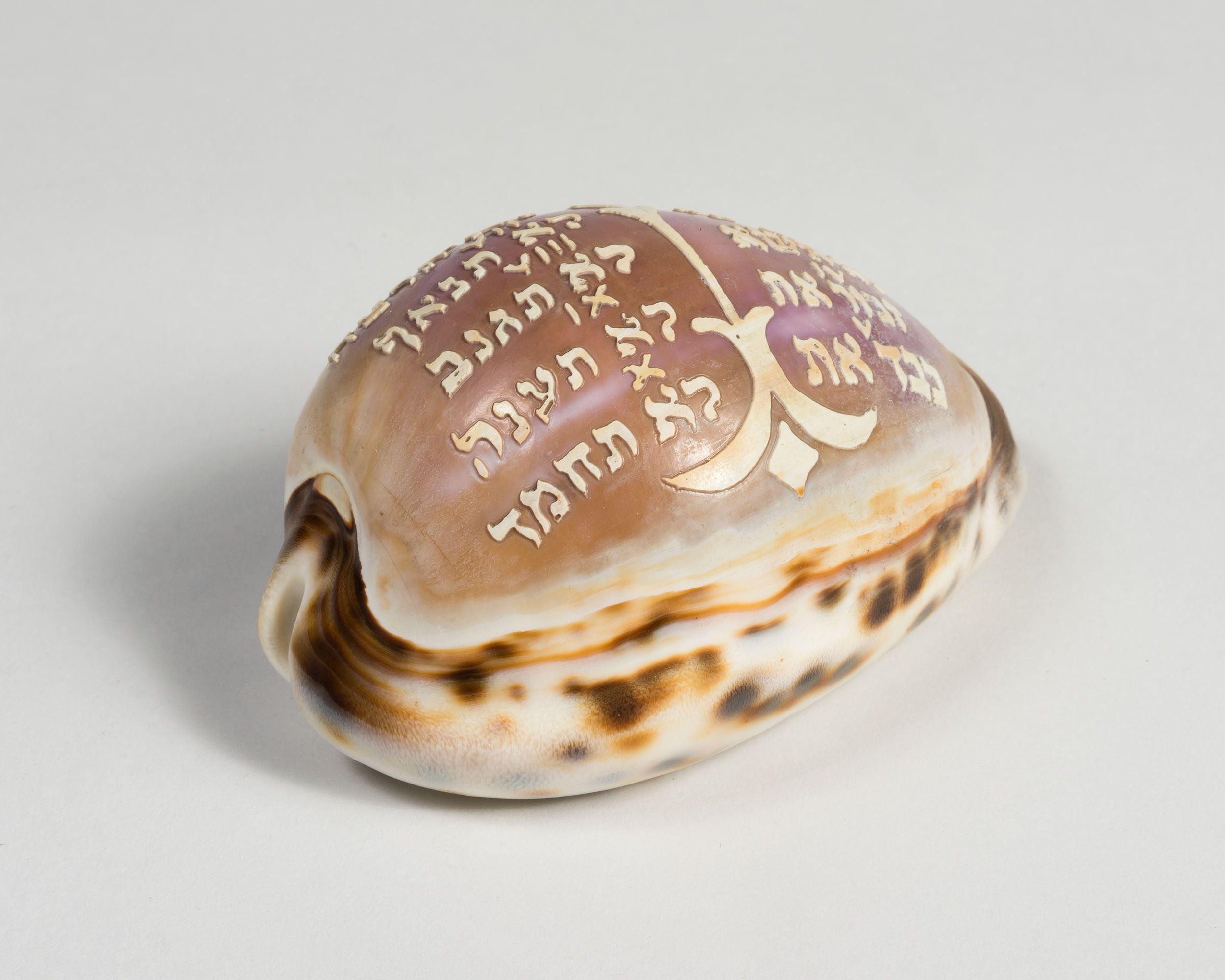
Work
Souvenir shell
Date
First half of the twentieth century
Artist
Unknown
Place Made
Jerusalem?
Medium
Acid-etched cowrie shell
Credit Line
Gift of Dr. Harry G. Friedman?, F 2817
The Temple Mount is depicted.

Work
Souvenir shell
Date
First half of the twentieth century
Artist
Unknown
Place Made
United States?
Medium
Acid-etched conch shell
Credit Line
Gift of Dr. Harry G. Friedman?, F 3846
